Physical Address
304 North Cardinal St.
Dorchester Center, MA 02124
Within the past century, pandemic infections, including the 1918 influenza pandemic, human immunodeficiency virus (HIV)-acquired immunodeficiency syndrome (AIDS), H1N1 ‘swine’ influenza, Zika virus and, at the time of writing, SARS-CoV-2, remind us how the ease and frequency of worldwide travel to both remote and urban areas facilitate the potential for infections to arrive in almost any part of the world within their incubation period. , Pathologists historically and contemporarily play an important role in infectious disease outbreaks and continue to be challenged to identify the histopathological manifestations of nonendemic, emerging and re-emerging infectious diseases. As a major blood-filtering organ, receiving portal and systemic circulation, the liver is involved in the majority of infections. With almost 30% of the body’s reticuloendothelial system by mass, the large component of phagocytic Kupffer cells that engulf blood-borne bacteria, fungi and protozoa ensures that hepatomegaly is almost as frequent as fever.
Some viral infections are solely hepatotropic, and Chapter 6 describes the classic viral hepatitides. This chapter discusses non-hepatotropic viral, bacterial and parasitic infections. Despite the diversity of infectious agents that affect the liver, morphological patterns of hepatic injury are limited; thus, ancillary diagnostic techniques such as immunohistochemistry (IHC) and molecular testing are often employed to help confirm the diagnosis. This chapter describes the histological features that may help differentiate various infectious diseases and identifies infections for which ancillary testing is particularly useful. Infections and their histopathological features are generally described in taxonomic groupings. The final section discusses the hepatic manifestations of HIV infection and AIDS.
This chapter covers numerous infectious agents but cannot detail all the appearances that assist in discriminating among possible diagnoses. An encyclopaedic description of the clinical and pathogenic aspects of infectious diseases can be found in textbooks by Mandell et al. , The pathological features of protozoal and helminthic diseases of the liver and other organs are illustrated and discussed by Gutierrez, and the U.S. Armed Forces Institute of Pathology (AFIP) volumes cover the pathology of most infections. Parasite life cycles are not detailed in this chapter, and the reader is referred to standard texts and the U.S. Centers for Disease Control and Prevention (CDC) website ( http://www.cdc.gov/dpdx/az.html ).
The viral haemorrhagic fevers (VHFs) encompass six families of enveloped RNA viruses—Arenaviridae, Filoviridae, Flaviviridae, Hantaviridae, Nairoviridae and Phenuiviridae (the latter three families were previously included in the now defunct Bunyaviridae family, i.e. Crimean-Congo haemorrhagic fever (CCHF), Rift Valley fever and Huaiyangshan or severe fever with thrombocytopenia syndrome virus [SFTS] and hantaviruses) —that share several epidemiological and clinical characteristics and display similar pathological features in the liver. These zoonotic diseases primarily occur in humans in geographical areas delimited by the viral vector and reservoir species, which include arthropods, rodents, bats and nonhuman primates. The transmission cycle of VHFs (with the exception of dengue virus) may be perpetuated by direct human contact or exposure to aerosolized infective particles, imposing a substantial threat to public health. VHFs can cause a severe febrile illness associated with small-vessel damage and vascular dysregulation in multiple organs, leading to haemorrhage and hypotension. The clinicopathological features of VHFs have been reviewed. , Table 7.1 summarizes select VHFs with their geographical distribution, associated vector and hepatic pathology.
| Viral family | Disease | Distribution | Vector | Pathological features in the liver |
|---|---|---|---|---|
| Flaviviridae | Yellow fever | Africa, South America | Mosquito ( Aedes, Haemagogus ) | Midzonal hepatic necrosis, acidophilic bodies, steatosis, minimal inflammation |
| Dengue HF | Africa, Asia, tropical America | Mosquito ( Aedes ) | Midzonal and centrizonal hepatic necrosis, acidophilic bodies, steatosis, minimal inflammation | |
| Arenaviridae | Lassa fever | West Africa | Rodents ( Mastomys ) | Variably spotty to confluent hepatic necrosis, minimal inflammation |
| Argentine HF (Junin virus) | Argentina | Rodents ( Calomys musculinus ) | ||
| Bolivian HF (Machupo virus) | Bolivia | Rodent ( Calomys callosus ) | ||
| Filoviridae | Ebola fever | Central, eastern and southern Africa | African fruit bat | Intracytoplasmic viral inclusions, spotty to confluent hepatic necrosis |
| Marburg fever | Central and southern Africa | African fruit bat ( Rousettus aegyptiacus) | Spotty to confluent hepatic necrosis | |
| Nairoviridae | Rift Valley fever | East and central Africa | Mosquito ( Aedes ) | Massive hepatic necrosis, minimal inflammation |
| Phenuiviridae | Crimean-Congo HF | Former Soviet Union, central-west Asia, Africa | Tick ( Hyalomma ) | Massive hepatic necrosis, minimal inflammation |
Yellow fever (YF) is a member of the Flaviviridae family of viruses and is endemic in tropical Africa and South America, where the Aedes and Haemagogus mosquito vectors reside. The true incidence of disease remains unknown, but the World Health Organization (WHO) has estimated that 84,000 to 170,000 cases and up to 60,000 deaths occur annually, the majority in Africa. Disease outbreaks are more often reported in West Africa, particularly in areas where mass vaccination campaigns have been interrupted, but large outbreaks have also erupted in Uganda, Sudan and Ethiopia. , Severe re-emergence events have also occurred in Brazil where nonendemic areas have experienced major outbreaks with case fatality rates up to 43%. In a 2017–2018 outbreak of YF in Brazil, among the 2585 reported cases, 571 cases were confirmed in Sao Paulo, the most developed state. The YF pattern was ‘rural’ or sylvatic but cases emerged in the neighbourhoods of large cities.
Approximately 30% of those infected with YF will manifest symptoms. The clinical stages of disease (acute infection, remission, intoxication) begin with sudden onset of fever and headache associated with nausea and vomiting lasting 3–4 days; high fever can be accompanied by paradoxical bradycardia (Faget sign). Liver enzymes are modestly elevated early in the disease. Symptoms may resolve for up to 2 days but return in the stage of ‘intoxication’ with fever, vomiting and jaundice. During this stage, aminotransferase levels are greatly elevated. Aspartate transaminase (AST) is typically higher than alanine transaminase (ALT), unlike in viral hepatitis, which shows the reverse profile. In the third and final stage of disease, patients develop jaundice, severe coagulopathy and a bleeding diathesis leading to multiorgan failure and death. There is no specific treatment for YF apart from supportive care. The diagnosis can be suspected based on clinical features and travel history and is usually confirmed by the serological demonstration of specific immunoglobulin M (IgM) using enzyme-linked immunosorbent assay (ELISA). Specialized testing of tissue samples using IHC or viral culture can also be performed by the CDC.
At autopsy, the gross appearance of the liver belies the microscopic severity of disease, as the liver typically maintains its size (or is slightly enlarged) and contour. If autopsy is performed on patients promptly after death, the external surface of the liver is typically reddish grey, but if autopsy is delayed for 6–12 hours, the surface may appear yellow. On cut section, the parenchyma is also variably yellow due to steatosis ( Fig. 7.1A ). Microscopically, the classic histopathological features include hepatocyte swelling, confluent midzonal necrosis with sparing of periportal and centrizonal hepatocytes, and steatosis. Inflammation is scant, and cholestasis is unusual. Apoptosis is the predominant mechanism of cell death and is manifested by acidophilic degeneration of hepatocytes with loss of nuclei forming the classic but nonspecific acidophilic (‘Councilman–Rocha Lima’) bodies ( Fig. 7.1B, C ). The preferential midzonal localization of apoptosis can be attributed to direct injury by virus, hypoxia and cell-mediated immunity. Rarely, eosinophilic intranuclear inclusions (Torres bodies) are present. Immunohistochemical stains highlight the distribution of abundant YF antigens in hepatocytes and Kupffer cells throughout the hepatic midzone ( Fig. 7.1D ). Electron microscopy (EM) can be used to demonstrate the ultrastructural characteristics of the 40-nm virions ( Fig. 7.1E ). Fatty change, particularly prominent in the perivenular zone, is typical of YF and includes large- and small-droplet macrovesicular steatosis, as well as microvesicular steatosis, the latter demonstrated by EM. The surviving liver shows hepatocyte swelling and regenerative hyperplasia with frequent multinucleated hepatocytes. A mild portal-based lymphocytic infiltrate may be observed, but inflammation is generally minimal. In their detailed series of 93 YF autopsies, Klotz and Belt did not observe a correlation between the clinical severity of disease and the extent of liver injury.
![Figure 7.1, Yellow fever. (A) Gross image of liver in fatal case of yellow fever. (B) Extensive midzonal hepatic necrosis with minimal portal inflammation. (Haematoxylin and eosin [H&E] stain.) (C) High-power magnification with acidophilic (‘Councilman–Rocha Lima’) bodies (arrow) and small-droplet steatosis. (D) Immunohistochemical assay highlighting midzonal hepatocellular distribution of yellow fever viral antigens in red. (E) Virus particles (upper arrow) are seen in the rough endoplasmic reticulum. Virions are 40 nm in diameter with a dense core surrounded by the envelope. Also seen are smooth membrane vesicles (lower arrow), the replication complex for this virus. Bar represents 100 nm. (F) Portal-based inflammation and sinusoidal infiltrates in a case of yellow fever vaccine-associated viscerotropic disease. (H&E stain.)Figure 7.1 cont’d(G) Immunohistochemical assay highlighting distribution of yellow fever antigens in portal-based fibroblasts and Kupffer cells (immunoalkaline phosphatase staining, naphthol fast red substrate with haematoxylin counterstain). (H, I) Late-onset relapsing hepatitis associated with yellow fever showing (H) the typical pattern of ‘lobular hepatitis’ with apoptosis and spotty necrosis of hepatocytes; Kupffer cells are hypertrophic. (I) Confluent necrosis with mixed inflammation. Hypertrophic Kupffer cells are found in dilated sinusoids. (J) Immunohistochemical detection of YF antigen almost entirely restricted to the cytoplasm of hypertrophic Kupffer cells in an area of minimal lobular inflammation. (K) YF antigen more intensely immunostained in an aggregate of macrophages in a moderately inflamed hepatic lobule. Figure 7.1, Yellow fever. (A) Gross image of liver in fatal case of yellow fever. (B) Extensive midzonal hepatic necrosis with minimal portal inflammation. (Haematoxylin and eosin [H&E] stain.) (C) High-power magnification with acidophilic (‘Councilman–Rocha Lima’) bodies (arrow) and small-droplet steatosis. (D) Immunohistochemical assay highlighting midzonal hepatocellular distribution of yellow fever viral antigens in red. (E) Virus particles (upper arrow) are seen in the rough endoplasmic reticulum. Virions are 40 nm in diameter with a dense core surrounded by the envelope. Also seen are smooth membrane vesicles (lower arrow), the replication complex for this virus. Bar represents 100 nm. (F) Portal-based inflammation and sinusoidal infiltrates in a case of yellow fever vaccine-associated viscerotropic disease. (H&E stain.)Figure 7.1 cont’d(G) Immunohistochemical assay highlighting distribution of yellow fever antigens in portal-based fibroblasts and Kupffer cells (immunoalkaline phosphatase staining, naphthol fast red substrate with haematoxylin counterstain). (H, I) Late-onset relapsing hepatitis associated with yellow fever showing (H) the typical pattern of ‘lobular hepatitis’ with apoptosis and spotty necrosis of hepatocytes; Kupffer cells are hypertrophic. (I) Confluent necrosis with mixed inflammation. Hypertrophic Kupffer cells are found in dilated sinusoids. (J) Immunohistochemical detection of YF antigen almost entirely restricted to the cytoplasm of hypertrophic Kupffer cells in an area of minimal lobular inflammation. (K) YF antigen more intensely immunostained in an aggregate of macrophages in a moderately inflamed hepatic lobule.](https://storage.googleapis.com/dl.dentistrykey.com/clinical/NonHepatotropicViralBacterialandParasiticInfectionsoftheLiver/0_3s20B9780702082283000077.jpg)
Although a prompt and complete hepatic recovery is anticipated to occur in patients who survive an attack of YF, a nonspecific lobular hepatitis was described in 1972 during an epidemic in Nigeria, in four patients biopsied from 16 to 62 days after the onset of acute illness; the authors thus suggested that liver damage associated with YF infection can persist, and healing may not be as rapid as previously thought. In a more recent study of the 2017–2018 Brazilian YF outbreak, Casadio et al. reported on the follow-up of 58 patients who survived severe acute YF and were negative for YF-RNA at the time of hospital discharge; these patients were followed as part of a clinical trial of sofosbuvir for the treatment of acute YF. Twenty-six (45%) of the patients in the trial presented with clinical and/or laboratory evidence of late-onset relapsing hepatitis, defined as a new elevation in aminotransferase levels within 6 months after the original improvement of liver function. The interval from hospital discharge to the new ALT peak was 59 ± 19 days and the duration of the altered ALT level ranged from 51 to 176 days. Nine of these 26 cases underwent liver biopsy, and the liver showed lobular necroinflammation, with many foci of spotty necrosis. Apoptosis and hydropic regeneration were found in all lobular zones, without the typical midzonal lesions of YF. Some of the patients had confluent necrosis and Kupffer cell hypertrophy was present in all cases. Unlike the immunohistochemical pattern of classic acute YF, immunohistochemical detection of YF antigens in all nine late-onset relapsing hepatitis cases was mainly localized to the cytoplasm of Kupffer cells. All 26 patients with late-onset relapsing hepatitis recovered clinically with normal levels of liver enzymes. These findings may substantiate a longer period of observation postinfection.
Orthotopic liver transplantation (OLT) was performed in seven cases from the 2017–2018 Brazil outbreak. Three patients recovered, but four patients died. Autopsies revealed characteristic histological features of YF hepatitis in all engrafted livers. YF antigen was detected by IHC in the heart in one case, liver and testis in three cases and the kidney and spleen in all four fatal cases. YF virus RNA was also detected by reverse-transcriptase polymerase chain reaction (RT-PCR) in the liver and in other organs in all of the fatal cases. These findings suggest that infection of the engrafted liver and other organs by YF, possibly combined with major ischaemic systemic lesions, may have led to the death of four of the seven patients undergoing OLT.
A live, attenuated YF vaccine is available for those living in countries where YF is endemic and for international travellers. Although serious adverse reactions to the vaccine are rare, cases of ‘YF vaccine-associated viscerotropic disease’ (YEL-AVD) emerged in 2001 and have been reported in countries worldwide, with an estimated incidence of 0.4 cases per 100,000 doses of vaccine. YEL-AVD is characterized by multiorgan failure and a high-level viraemia that can reach 1000 times greater than levels expected for vaccination alone.
There are notable histopathological and immunohistochemical differences between wild-type YF virus infections and YEL-AVD. In wild-type disease, inflammation is minimal and hepatic necrosis predominates; on IHC, YF antigens are detected in the liver and are predominantly localized within necrotic hepatocytes. In contrast, the features of YEL-AVD include a prominent portal-based mononuclear and sinusoidal infiltrate in the absence of confluent necrosis ( Fig. 7.1F ). On IHC in YEL-AVD, YF viral antigens are detected in portal-based mesenchymal cells as well as Kupffer cells lining hepatic sinusoids (also similar to the pattern seen in late-onset relapsing hepatitis). Importantly, viral antigens in YEL-AVD are also detected throughout visceral organs ( Fig. 7.1G ), unlike in wild-type disease, where antigens are limited to the liver.
The pathogenesis of YEL-AVD has not been fully elucidated. No definitive genetic predisposition has been identified in affected patients, and no significant mutations that alter the virulence of the vaccine strains have been detected. Studies have shown that those with thymic disease and individuals over age 60 harbour a greater risk of YEL-AVD, , but this adverse reaction has also been reported in patients as young as 4 years old and those without known underlying disease.
Dengue virus is another flavivirus and is transmitted by Aedes aegypti and Aedes albopictus mosquitoes. Initial exposure to one of the five viral serotypes can be asymptomatic or can result in dengue fever, a self-limiting influenza-like illness with symptoms of fever, rash, arthralgias and myalgias (‘breakbone fever’). The clinically more severe diseases, dengue haemorrhagic fever (DHF) and dengue shock syndrome (DSS), now defined as severe dengue, are caused by reinfection with a viral serotype that differs from the first infection. The pathogenesis of severe dengue is complex, including, among others, recent demonstration of strong systemic proinflammatory response. Thrombocytopenia leads to widespread petechial haemorrhage, capillary leakage and fluid depletion, resulting in multiorgan failure. , Children are disproportionately affected by severe dengue. Untreated, the mortality approaches 30%.
In DHF/DSS or severe dengue, the liver at autopsy is enlarged, pale from steatosis and blotchy from multifocal haemorrhage. None of the histopathological features seen in DHF/DSS is considered pathognomonic. Microscopically, there are variable amounts of spotty, confluent perivenular or midzonal hepatic necrosis, with little or no inflammation; cell death is through apoptosis ( Fig. 7.2A ). As with other VHFs, acidophilic bodies and steatosis may also be seen. On IHC, dengue viral antigens are predominantly identified within Kupffer cells ( Fig. 7.2B ), in contrast to YF, where hepatocytes are preferentially infected.
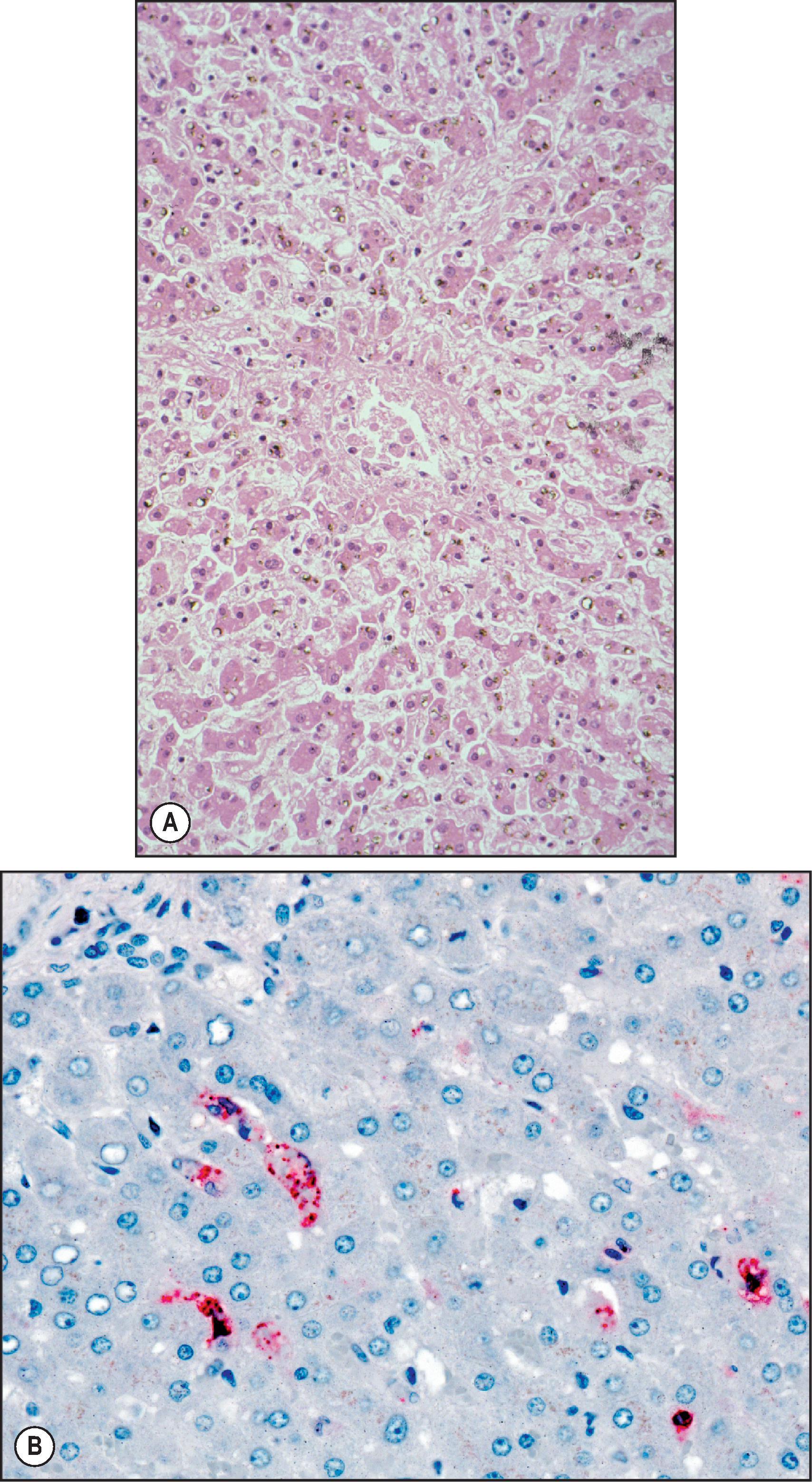
Ultrastructural findings in the liver have been described in a series of seven autopsy cases in children ages 3–9 years with fulminant DHF who died within the first week of illness. The features included abundant lysosomes with varied content and sizes, vacuolization, steatosis and damaged and swollen mitochondria with distorted or damaged cisternae as evidence of cellular injury. The endoplasmic reticulum and Golgi system showed dilated cisternae or vesicle formations. Viral particles were rarely found, however, and not in arrays within vesicles as previously reported in experimental infections. Although there was ample evidence of hepatocyte damage, no viral-induced replicating structure was identified in this study. Thus, in DHF, the evolution of liver injury in fulminant DHF may occur independent of active viral replication, but this remains an area of further study.
Arenaviruses are classified into two broad groups: Old World viruses identified in the Eastern Hemisphere, such as Lassa virus and lymphocytic choriomeningitis virus (LCMV), and New World viruses identified in the Western Hemisphere, such as Junin virus and Machupo virus. This family of viruses is transmitted by various rodent species, but some viruses (e.g. Lassa, Machupo, Lujo) can also be spread from person to person. Most arenaviral infections cause a flu-like illness, but haemorrhagic fever (HF) syndromes can be caused by infections with LCMV, Junin virus (Argentine HF), Machupo virus (Bolivian HF), Guanarito virus (Venezuelan HF), Sabia virus (Brazilian HF), Chapare virus (Chapare HF) and Lassa virus. ,
Lassa virus was first described in the late 1960s and is the most common arenavirus. The natural reservoir of Lassa virus is the multimammate rat, Mastomys natalensis , and humans are infected by direct exposure to its urine. After the alarming emergence of the disease in the early 1970s, serological surveys have shown that the infection is widespread in West Africa; however, clinical disease occurs in 5–10%, and the case-fatality rate is <25%. The clinical features include abdominal pain, pharyngitis and fever, but not jaundice. Hepatitis is common in Lassa fever but is mild or absent in the South American HFs. In contrast, haemorrhage, neurological involvement, leukopenia and thrombocytopenia are more often seen in the South American HFs than in Lassa fever.
Grossly, arenavirus infections cause mottling of the liver ( Fig. 7.3A ). Histologically, there is pauci-inflammatory necrosis, and individual hepatocytes or groups of cells throughout the acini appear acidophilic ( Fig. 7.3B ). There is no cholestasis or steatosis, but lipofuscin deposition is evident. Arenaviruses can be seen on EM, but there are no light microscopy viral inclusions. On IHC, abundant viral antigens can be seen lining hepatocytes and sinusoids ( Fig. 7.3C ).
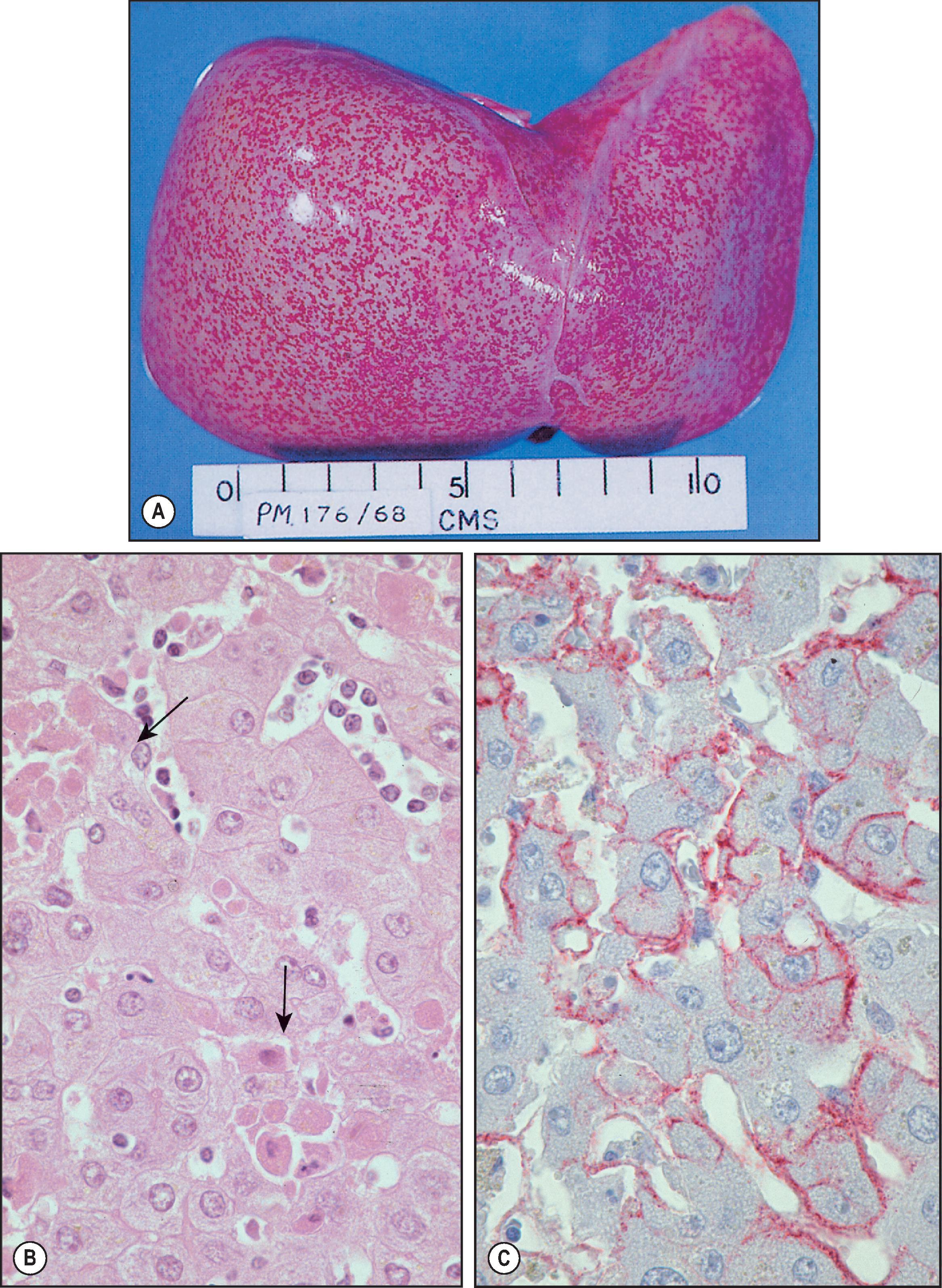
The histopathological features of other arenaviral infections, including Argentine HF (Junin virus) and Bolivian HF (Machupo virus), are strikingly similar ( Fig. 7.4A–C ). Lujo virus is a novel, highly fatal arenavirus first identified in southern Africa in 2008 and is named for the cities involved in the disease outbreak (Lusaka and Johannesburg) ( Fig. 7.4D, E ). LCMV was the first arenavirus discovered and isolated in 1933 and is distributed worldwide. Infection can be asymptomatic in immunocompetent hosts but can cause severe disease, most notably aseptic meningitis, in immunosuppressed patients. Outbreaks of severe LCMV infection have been described in transplant recipients , ( Fig. 7.4F–H ).
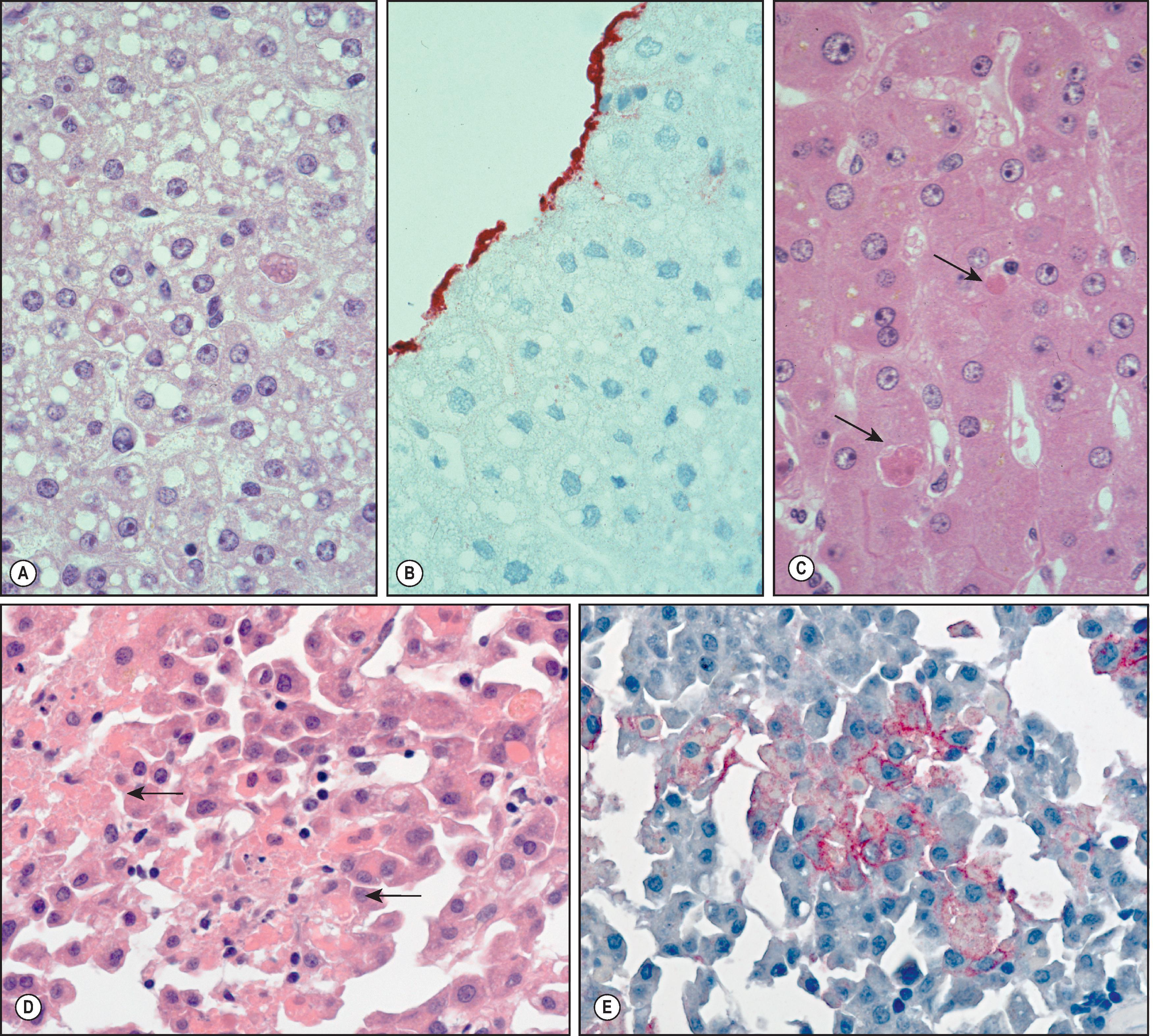
Viruses of the Ebolavirus and Marburgvirus genera (family Filoviridae) cause sporadic outbreaks of HF in Africa with high case-fatality rates. Marburg virus disease (MVD) was identified first in 1967 when a small cluster of laboratory workers in the university town of Marburg, Germany, became sick after working with African green monkeys imported from Uganda. Subsequent isolated cases occurred in Kenya and South Africa up until 1982, followed by sporadic outbreaks in the Democratic Republic of the Congo (DRC) and Angola in 1998 and 2004; an isolated case occurred in November 2014 in Uganda. Ebola virus disease (EVD) was first identified in 1976 in Yambuko, DRC, but was named after the Ebola River to the north. EVD is caused by one of four Ebolavirus species ( Zaire, Sudan, Tai Forest, Bundibugyo ), but Zaire ebolavirus is the most virulent. The virus known as Reston ebolavirus does not cause disease in humans, and swine have been identified as the natural hosts. Filovirus outbreaks and large epidemics are perpetuated by person-to-person transmission. Although the source of filoviruses in nature has not been definitively identified, the cumulative evidence implicates bats as reservoirs. , The clinical manifestations of MVD and EVD include vomiting, fever, widespread haemorrhage, shock and disseminated intravascular coagulation.
The hepatic pathology of filoviruses is similar to that of other VHFs; there is variable spotty to confluent hepatocyte necrosis with minimal inflammation and no cholestasis. , Characteristic eosinophilic and filamentous intracytoplasmic viral inclusions can be identified within hepatocytes and are usually numerous in EVD ( Fig. 7.5A ). The viral inclusions and distribution of antigens can be confirmed by IHC ( Fig. 7.5B ). Ultrastructurally, the inclusions are composed of aggregates of viral nucleocapsids ( Fig. 7.5C ). Experimental studies show that the Ebola virus is present in large quantities free in the blood, throughout the mononuclear phagocyte system, in endothelial cells and in hepatocytes; the reticular network of lymph nodes is also heavily infected and damaged.
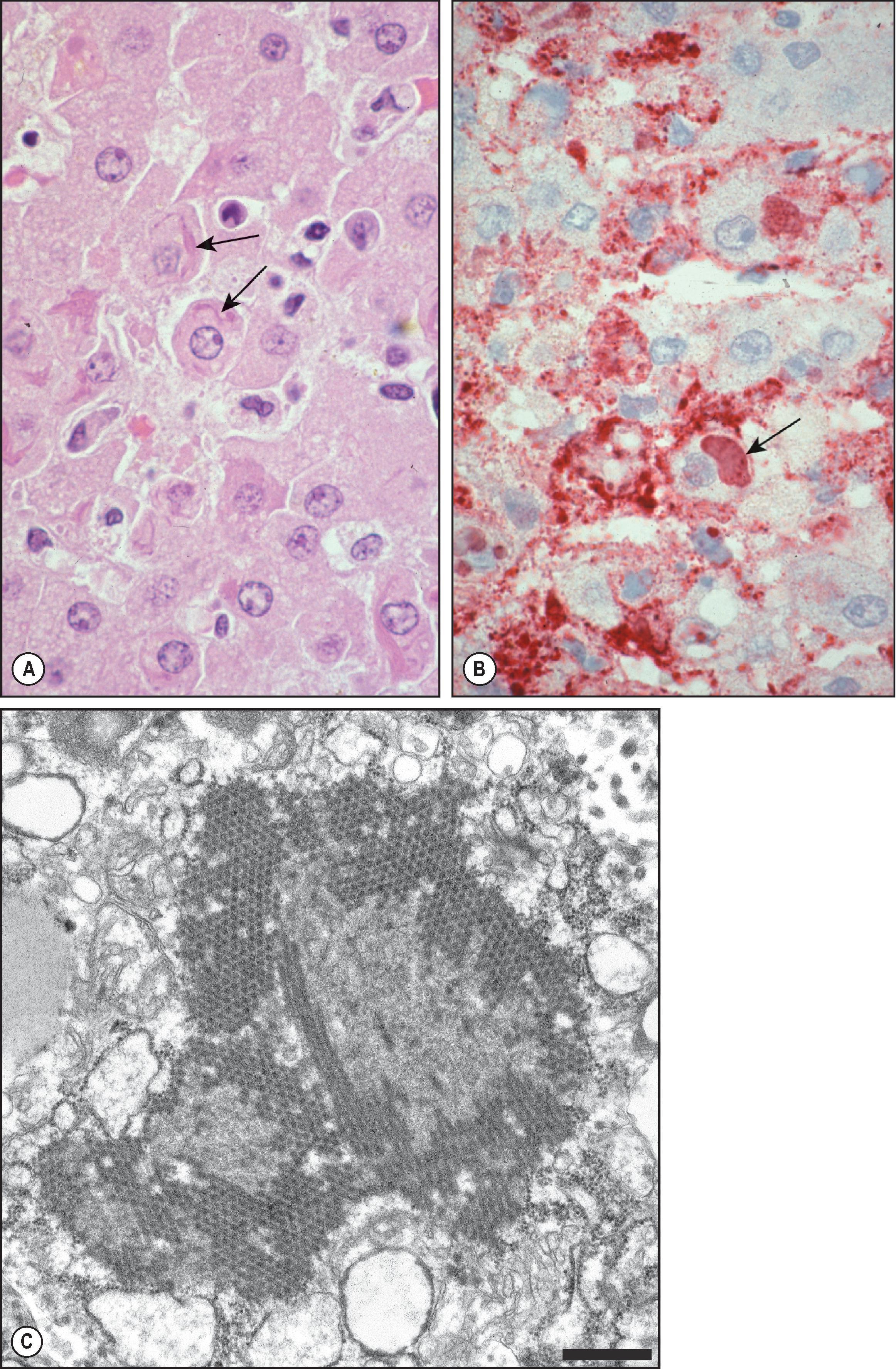
Filovirus infections remain critically relevant. In 1995, 2000, 2007 and 2008, large Ebola virus outbreaks occurred throughout the DRC and Uganda, resulting in high mortality. The largest reported outbreak of EVD erupted in March 2014 in Guinea. The virus spread rapidly throughout West Africa, igniting an international public health emergency and resulting in more than 28,000 infections and 11,000 deaths. The potential for patients with VHF to travel to industrialized countries , was also realized during the 2014 Ebola epidemic, when a small number of imported cases occurred in Europe and the United States. , The more recent EVD outbreak in eastern DRC, which began in August 2018, was the world’s second largest, with a case-fatality rate of 66%, and was declared over in June 2020 as a new Ebola virus outbreak erupted in the west ( https://www.cdc.gov/vhf/ebola/outbreaks/drc/2018-august.html ).
Multiple Ebola vaccine candidates have been developed, as well as new therapeutic treatments, and four African countries now have licensed Ebola vaccines ( https://news.un.org/en/story/2020/02/1057461 , accessed 18 November 2020).
Crimean-Congo HF (CCHF) virus formerly belonged to the Bunyaviridae family and is now classified within the Nairoviridae family. CCHF is endemic in various countries in Africa, Asia and Eastern Europe. CCHF has emerged as an important human pathogen, probably as a result of improvements in surveillance and increased awareness. The clinical and histopathological features are similar to those of other VHFs ( Fig. 7.6A ). IHC and in situ hybridization (ISH) analysis show that mononuclear phagocytes, endothelial cells and hepatocytes are the main targets of infection ( Fig. 7.6B ). Rift Valley fever, family Phenuviridae , is another bunyavirus reported mainly in eastern and southern Africa, Egypt, Madagascar and the Arabian peninsula. The changes in the liver in this disease are similar to those seen in other VHFs. Midzonal necrosis is a common feature seen, and IHC can also help establish the diagnosis ( Fig. 7.6C, D ).
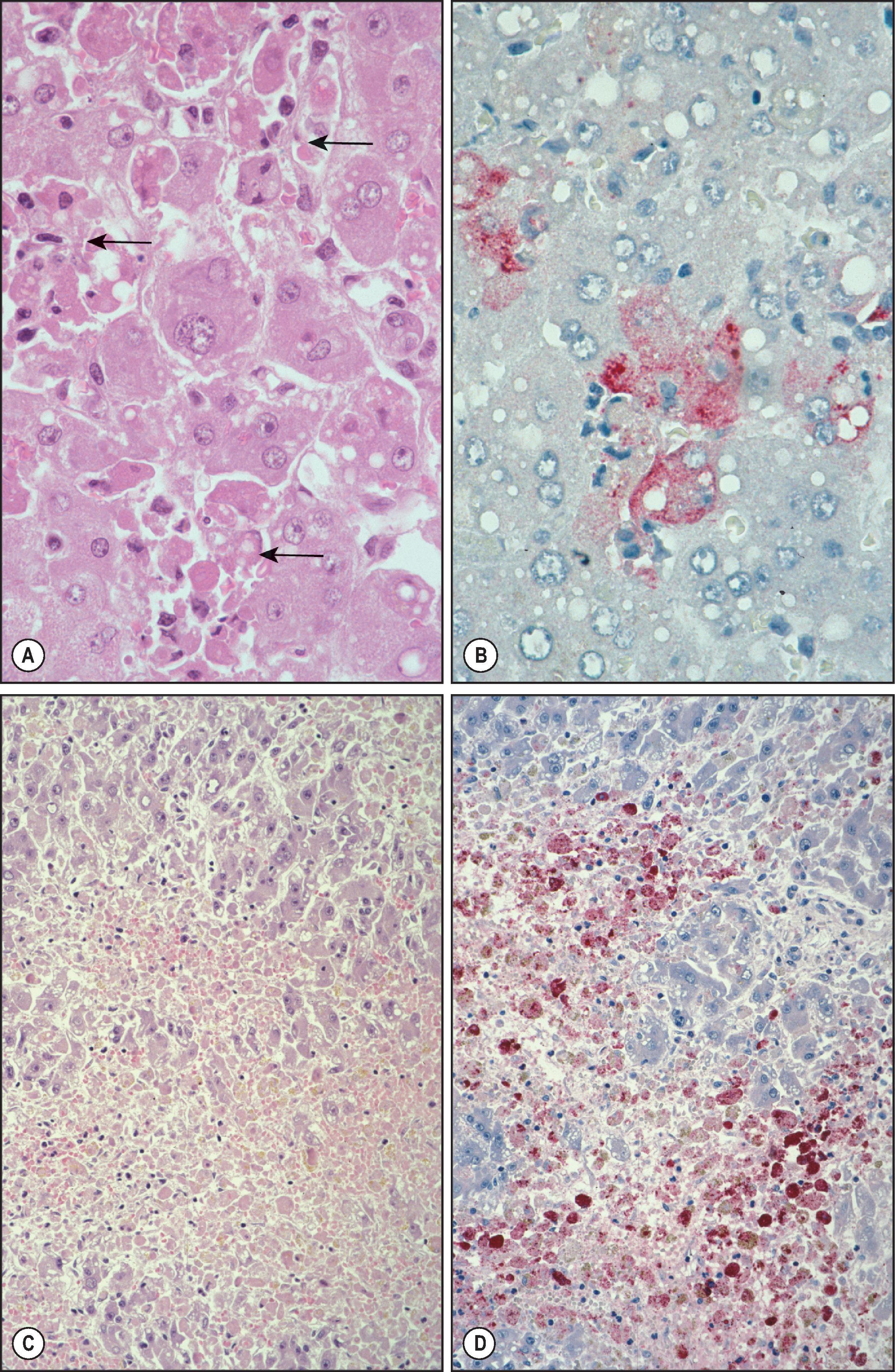
Within the genus Enterovirus are the coxsackieviruses (groups A and B), echoviruses, polioviruses and rhinoviruses. The clinical manifestations of these viruses vary from asymptomatic to severe and include meningitis, myocarditis and hepatitis as well as disseminated, systemic disease. Disease severity is correlated with age; in neonates, group B coxsackieviruses can produce particularly severe multisystemic disease with liver involvement, but in adults these viruses rarely cause hepatitis. The histopathological features in neonates are portal-based lymphohistiocytic inflammation and haemorrhagic necrosis ( Fig. 7.7A ). In adults, features include perivenular bile stasis and hydropic swelling of hepatocytes, accompanied by infiltration of mononuclear cells and neutrophils in the sinusoids and portal tracts. IHC can detect enterovirus-infected cells in formalin-fixed, paraffin-embedded (FFPE) tissues ( Fig. 7.7B ). Molecular assays, particularly gene amplification using PCR, have been developed to detect and serotype enteroviruses in formalin-fixed tissues.
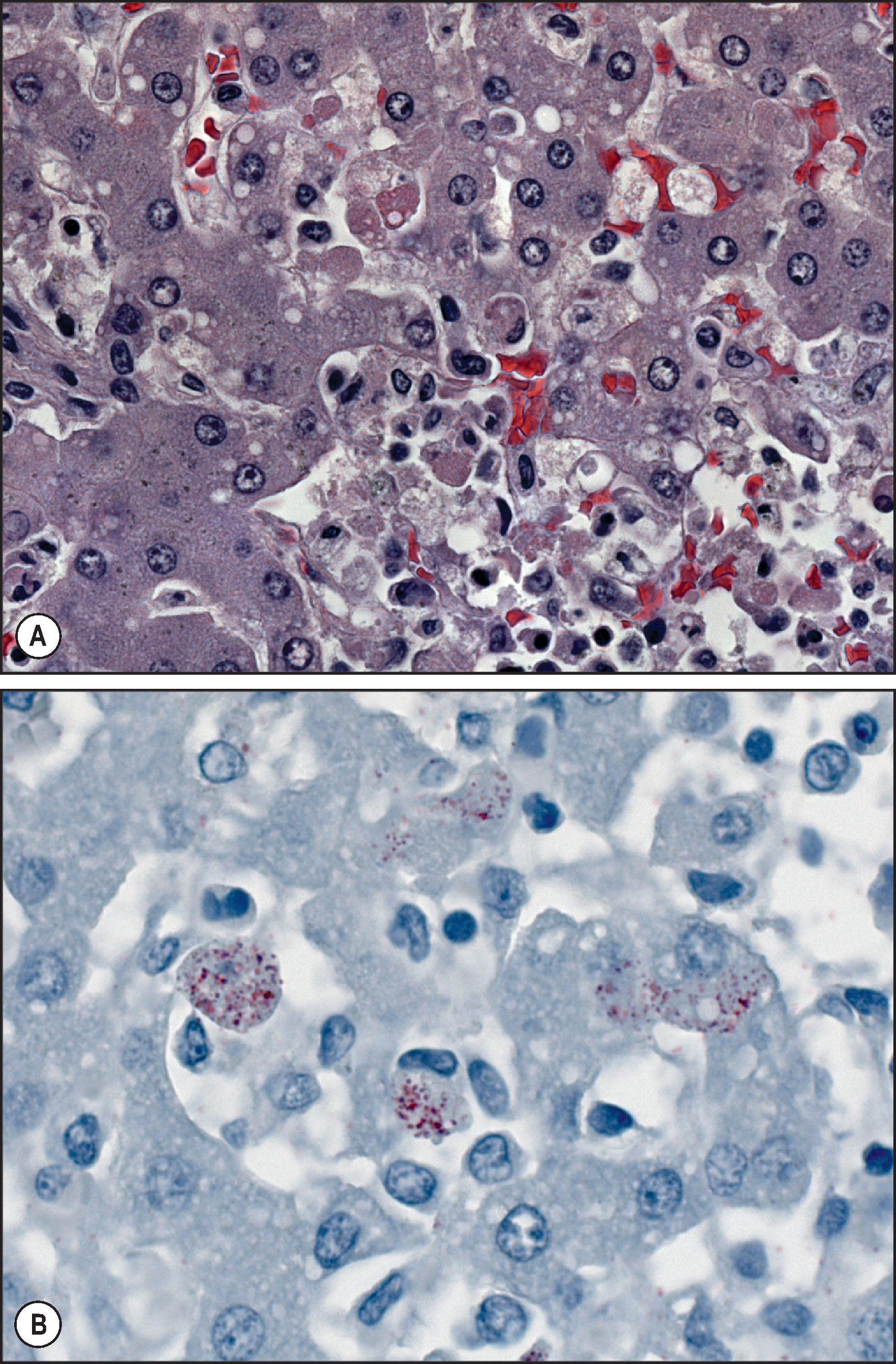
Chikungunya virus (ChikV) is a mosquito-borne alphavirus (family Togaviridae) that was first isolated in Tanzania in the early 1950s and has caused disease outbreaks throughout Africa, Asia and Europe. In 2013 the virus spread to the Americas. , Chikungunya (meaning ‘that which bends up’ in Makonde) is named for the postural changes induced by debilitating arthralgias. The acute phase of infection lasts approximately 10 days and is characterized by fever, maculopapular rash, myalgias and severe, typically symmetrical arthralgias that preferentially affect the fingers, wrists, toes and ankles. , The arthralgias can persist with variable morbidity. Fatal cases of chikungunya are rare but have been reported, particularly in older adults with underlying comorbidities. Clinical symptoms correspond to the histopathological features observed in mesenchymal tissues. Mononuclear inflammatory infiltrates are identified within the fibroconnective tissue of joints and tendons and in other collagenous connective tissues. There are no specific morphological features in visceral organs such as the liver that implicate the disease. In a review of 11 confirmed fatal chikungunya cases, the liver showed minimal to mild mononuclear portal inflammation in all cases and variable minimal to mild macrovesicular steatosis in 7 cases (64%), and rare single-cell necrosis in five cases (45%) ( Fig. 7.8A, C ). No granulomas or viropathic inclusions were identified. The features in the liver generally corresponded to patients’ underlying diseases; for example, steatohepatitis with moderate to severe steatohepatitis was observed in two patients (18%) with risk factors for fatty liver disease such as diabetes, hypertension and obesity.
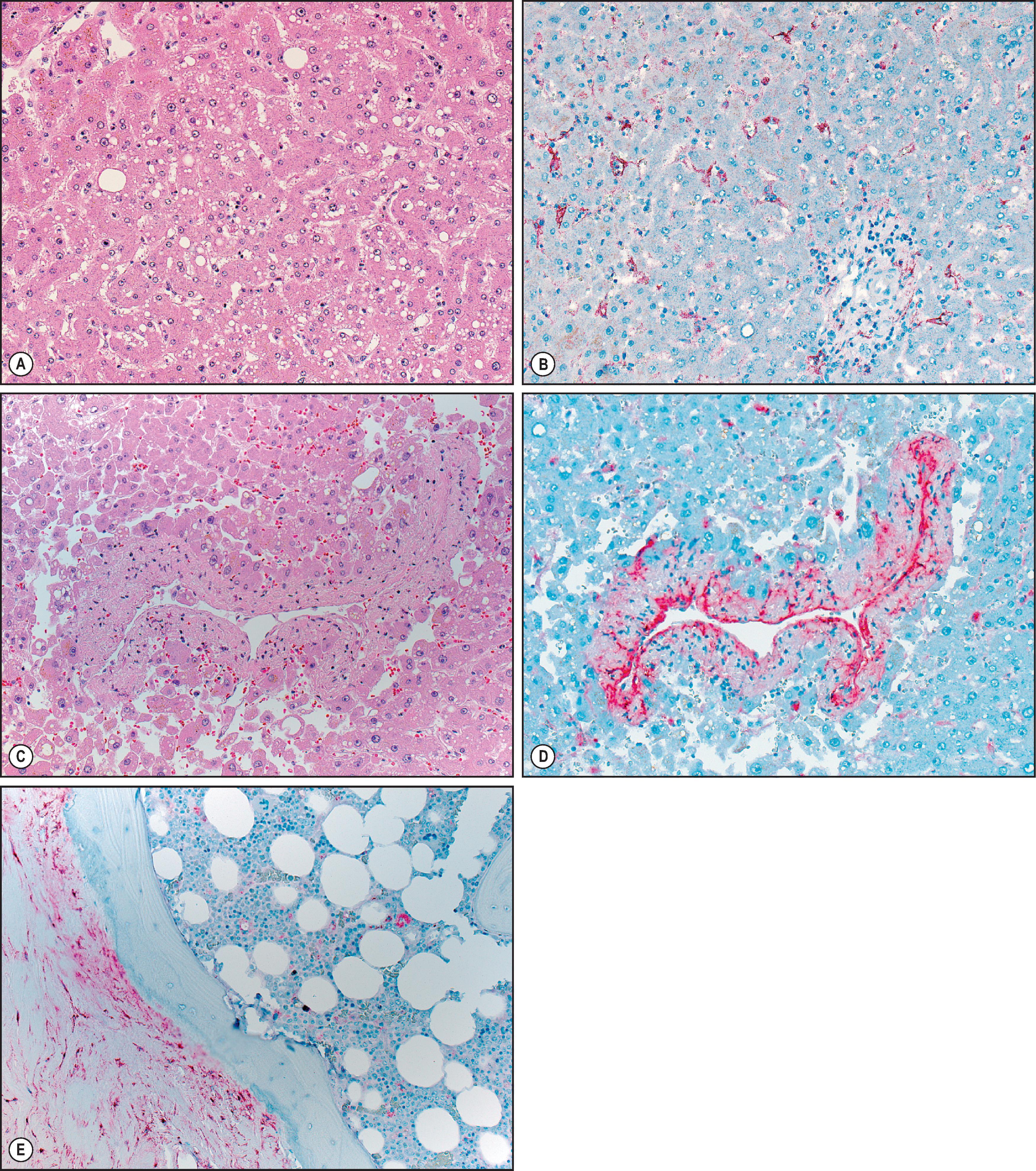
Despite minimal and nonspecific histopathological findings, immunohistochemical evidence of ChikV can be detected in the liver in approximately 50% of fatal cases. IHC highlights the localization of viral antigens in portal-based fibroblasts, Kupffer cells lining the sinusoids and smooth muscle within the wall of large veins ( Fig. 7.8B, D ). The presence of viral antigens throughout other mesenchymal tissues, such as periosteal fibroblasts ( Fig. 7.8E ), provides insight into characteristic joint pain.
Zika virus, a flavivirus transmitted by A. aegypti and A. albopictus mosquitoes, is briefly mentioned here because it is included in the clinical differential diagnosis of dengue fever and chikungunya infections. Zika virus was first identified in 1947 in the Zika forest of Uganda but spread east through French Polynesia in 2013 and erupted in an outbreak throughout the Americas in 2015. , Zika virus causes a mild viral syndrome in immunocompetent patients characterized by fever, rash, conjunctivitis, arthralgias and myalgias. Although the clinical manifestations overlap with dengue fever and ChikV, the histopathological features differ. Infections in pregnant women are of particular concern because they can cause spontaneous abortions and severe congenital infections with structural and functional lesions including microcephaly, arthrogryposis, dyskinesia and visual impairment. There is no treatment or vaccine available for Zika virus.
The histopathological features observed in confirmed cases of Zika virus are nonspecific; in first- and second-trimester placentas, prominent villous microcalcifications and perivillous fibrin are observed. In congenital infections, the fetal brain displays gliosis, glial nodules and microcalcifications. No specific histopathological abnormalities have been reported in the fetal liver. In first-trimester losses attributed to Zika virus infection, viral antigens can be detected by IHC in the chorionic villi of placental tissues. In the fetal brain, viral antigens are detected in neurons and glial cells. The full spectrum of the pathological features associated with Zika virus remains to be elucidated, but immunohistochemical and molecular assays can be performed on FFPE tissues at the CDC Infectious Diseases Pathology Branch.
SARS-CoV-2, the aetiological agent of coronavirus disease 2019 (COVID-19), is a novel single-stranded, enveloped RNA coronavirus that brought the world to a standstill in early 2020. The virus was first reported in Wuhan, China, in December 2019 with dozens of people that developed a mysterious febrile pneumonia-like illness, that then spread exponentially around the globe and was declared an international public health emergency by the WHO on January 30, 2020. , The global number of cases exceeded 494 million and global deaths over 6 million by April 2022 ( https://coronavirus.jhu.edu/map.html ). The specific origin of the virus remains under investigation, but bats are considered likely reservoirs. SARS-CoV-2 is transmitted from person to person by respiratory droplets and infects the upper respiratory tract through interaction of viral spike protein with endogenous angiotensin-converting enzyme 2 (ACE 2) receptors. Patients can develop fever, dry cough and dyspnoea, as well as severe disease requiring intubation and oxygen therapy, sometimes leading to death. The lungs show diffuse alveolar damage and organizing pneumonia, type 2 pneumocyte hyperplasia with reactive atypia ( Fig. 7.9A, B ). Many patients also have macro- and/or microscopic thrombi predominately within the respiratory and cardiovascular systems. , The evidence for the presence of ACE 2 receptors in the liver is limited, but expression is reported in intrahepatic endothelial cells, albeit to a far lesser extent in comparison to the lung. Autopsy studies have demonstrated the detection of viral ribonucleic acids in the liver, but no clear evidence of direct viral-mediated hepatotoxicity by SARS-CoV-2 has been identified, and no specific pathological alterations in the liver have been reported in fatal SARS-CoV-2 cases. The morphologic features in the liver in fatal cases typically reflect underlying liver disease (for example, steatohepatitis , ), but multiple studies indicate that obesity, fatty liver disease and cirrhosis are associated with increased mortality from COVID-19 disease ( Fig. 7.9 C). , Focal vascular findings in the liver, including phlebosclerosis involving portal venules and central vein, as well as arteriolar muscular hyperplasia and sinusoidal microthrombi, have also been reported. Similar to the observations of Elsoukkary et al., we also identified polymorphous basophilic aggregates in the sinusoids, which may be related to cellular injury such as NETosis and were not highlighted by a stain for calcium ( Fig. 7.9D ).
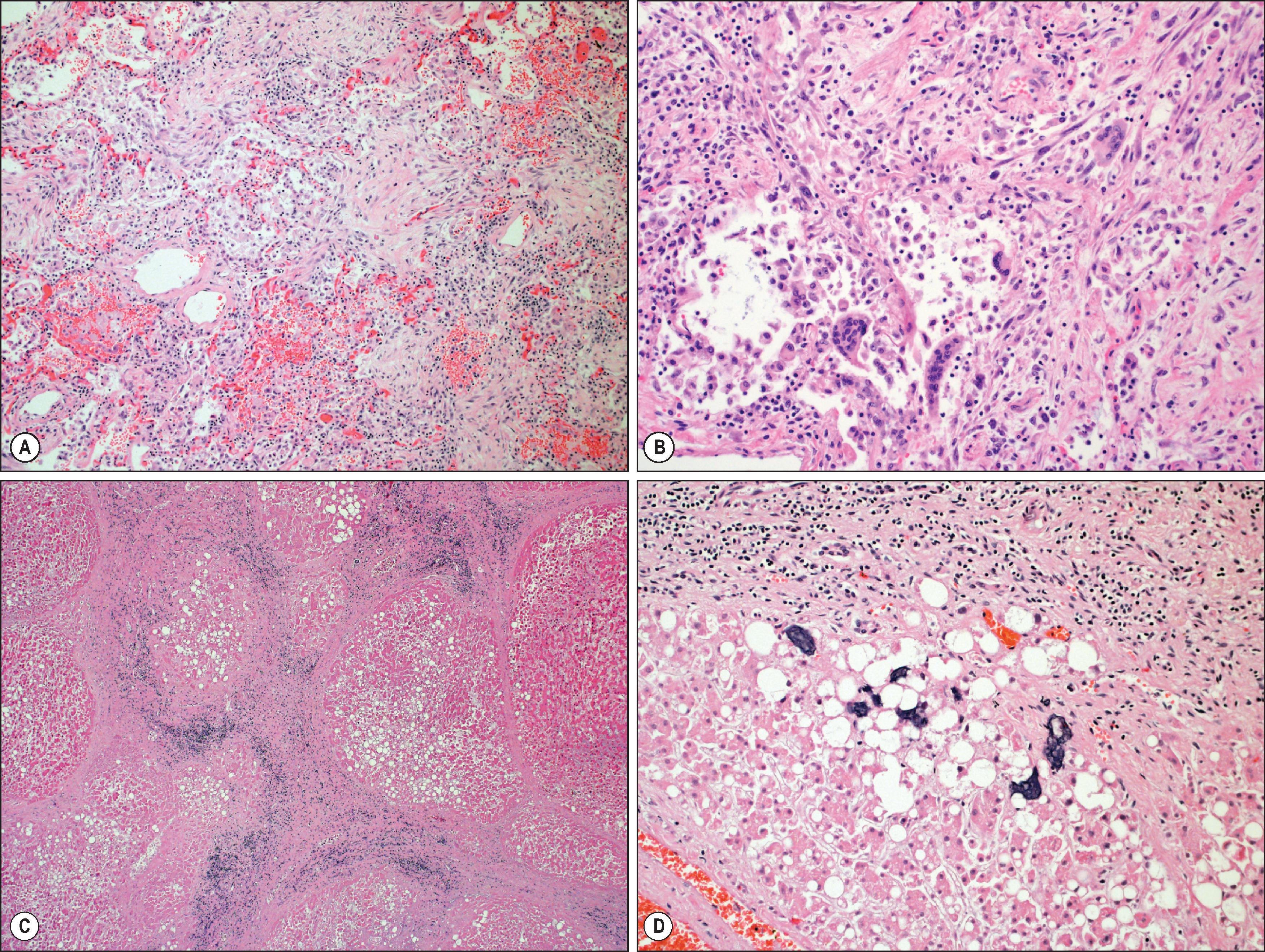
Heartland virus is a member of the Bunyaviridae family (genus Phlebovirus ) and was first identified in the United States in summer 2009 when two farmers living in northwestern Missouri developed a flu-like illness after receiving tick bites. The virus was isolated from the Lone Star tick ( Amblyomma americanum ), but the reservoir host is unknown. Signs and symptoms include fever, fatigue, headache, anorexia and diarrhoea. Laboratory findings are notable for thrombocytopenia and leukopenia. Four deaths have been reported among the approximately 10 cases of Heartland virus in the United States. Heartland virus is closely related to ‘severe fever with thrombocytopaenia syndrome virus’ (SFTSV), the only other tick-borne phlebovirus that causes disease in humans, which was described in central and northeastern China in 2011.
There are no pathognomonic histopathological features of Heartland virus. The morphological findings described in the liver are nonspecific and include macrovesicular steatosis and portal inflammation ( Fig. 7.10A ). Viral antigens are detected by IHC in Kupffer cells and in areas of portal-based inflammation ( Fig. 7.10B ), as well as in other organs, including the spleen ( Fig. 7.10C, D ) and lymph nodes.
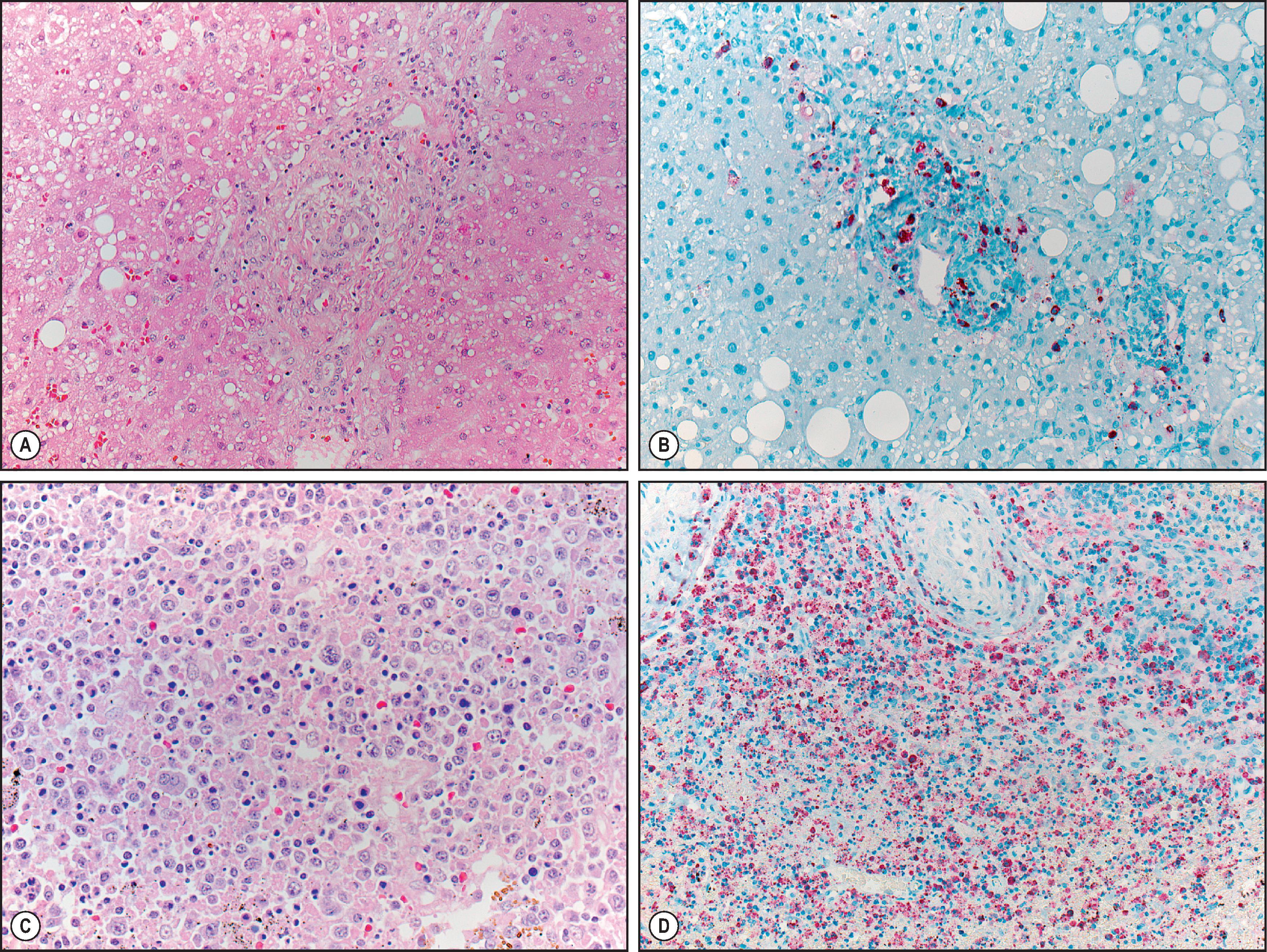
Worldwide, the prevalence of measles virus has fallen dramatically since the development of the first measles vaccine in 1963. However, this highly contagious viral infection remains a significant and preventable cause of morbidity and mortality. The majority of measles-associated deaths occur in African countries. Large outbreaks of disease continue to occur in countries such as the United States where the disease had been declared eliminated, fuelled by populations that choose not to receive vaccination. The classic clinical symptoms are fever, rash, cough, coryza and conjunctivitis. The morphological features in the liver are nonspecific and include steatosis (particularly when disease is associated with malnutrition), portal inflammation and spotty necrosis. Viral inclusions and giant cells are rarely seen ( Fig. 7.11A ) but have been reported in a patient with immunoglobulin deficiency , and can be highlighted by IHC ( Fig. 7.11B ). Inclusions may not be present in the liver when measles occurs in the setting of HIV infection. Measles can also cause an acute hepatitis syndrome in adults and rarely is associated with cholestasis and jaundice. ,
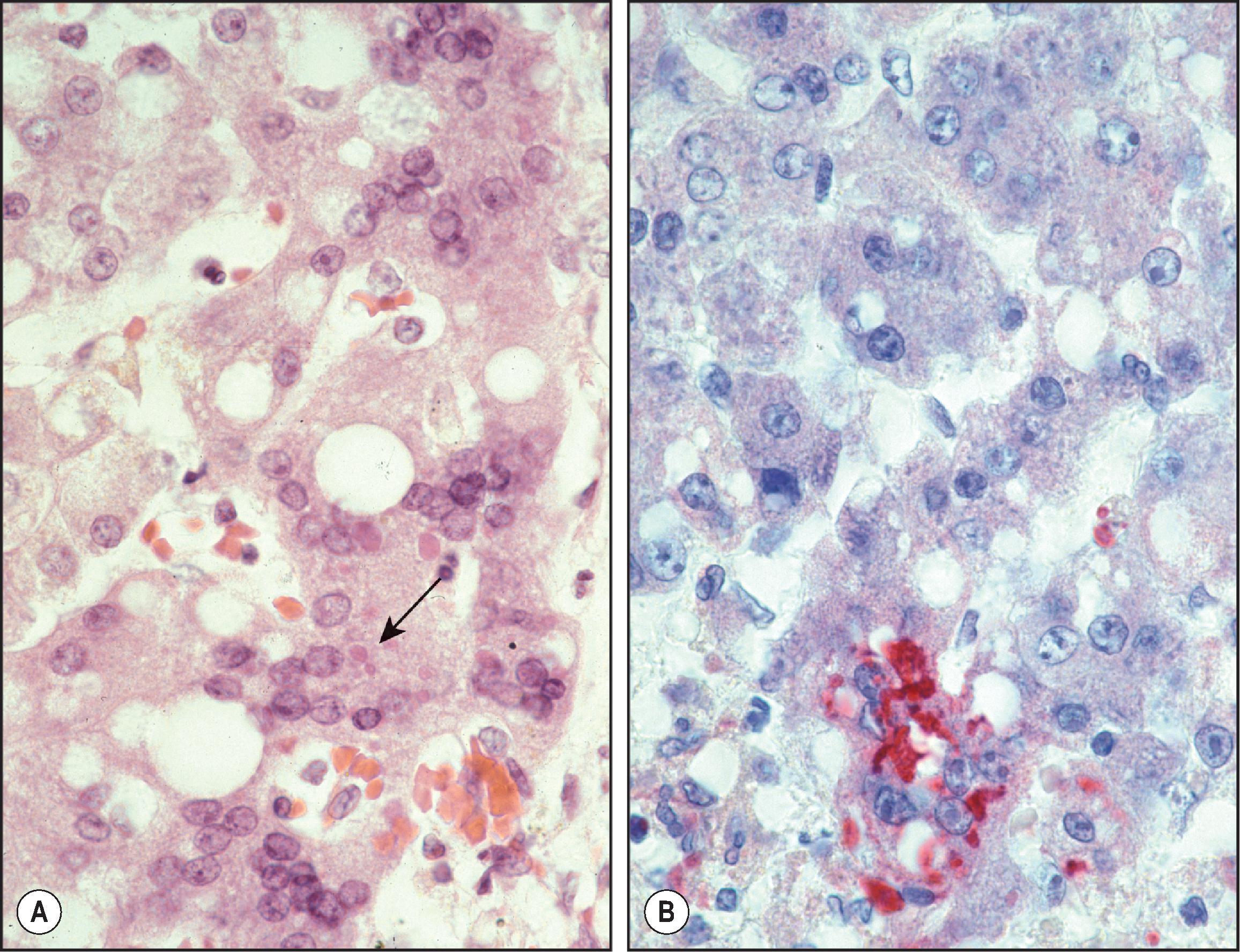
Childhood rubella is not associated with liver disease. However, this virus can be associated with giant cell transformation in neonatal hepatitis. In mild cases, spotty hepatocyte necrosis, cholestasis and a lymphocytic infiltrate occur, and rarely, there is massive necrosis.
The five members of this large group of DNA viruses that may directly affect the liver are herpes simplex virus (human herpesvirus) types 1 and 2 (HSV1/HHV1, HSV2/HHV2), varicella-zoster virus (VZV, HHV3), Epstein–Barr virus (EBV, HHV4), cytomegalovirus (CMV, HHV5) and HHV6. The Kaposi sarcoma virus (HHV8) is considered in the later section on HIV/AIDS. In most societies, infection is almost universal for most of the herpesviruses (except HHV8) and occurs in childhood or adolescence. Once infected with a herpesvirus, infection is lifelong, and therein lies the potential to reactivate and induce aggressive lesions in immunosuppressed persons.
Primary HSV infection produces oral or genital lesions and remains latent in neural ganglia for life. There are two strains of HSV: type 1 was previously more often associated with orolabial lesions, whereas type 2 more often caused genital lesions. However, recent data indicate that HHV1 is now the predominant cause of genital herpes lesions. Primary genital herpes infections can be asymptomatic or can produce vesicles on an erythematous base, reflecting viral replication within epithelial cells. After ascending sensory nerves, the virus enters a period of latency in the dorsal root ganglia. Genital infections in pregnant women can be transmitted to the developing fetus or neonate. Congenital transmission results in a triad of clinical features: cutaneous lesions, neurological abnormalities (e.g. microcephaly) and ocular disease (e.g. chorioretinitis). If HSV is acquired peripartum or postpartum, disease in the neonate may lead to skin, eye and mouth lesions (45% of cases), central nervous system (CNS) disease (30%) or disseminated disease (25%) with necrotizing hepatitis. Immunocompromised patients are also particularly at risk for severe fulminant systemic herpes infection. Fatal herpetic hepatitis is also reported in apparently immunocompetent adults. The clinical features resemble those of septic endotoxic shock; jaundice is not always present.
At autopsy, the liver in disseminated disease is enlarged and mottled with multiple yellow or white necrotic foci surrounded by congestion. Microscopically, there is irregular parenchymal coagulative necrosis with minimal, predominantly lymphocytic, portal-based inflammation ( Fig. 7.12A ). At the margins of necrotic zones, some hepatocytes display the classic amphophilic Cowdry type A intranuclear inclusions, with a clear halo and peripheral margination of chromatin, while surrounding hepatocytes show nuclear basophilia. Regenerative and reactive features are manifested by hepatocyte multinucleation and Kupffer cell hypertrophy ( Fig. 7.12B, E and F ). Unlike the distribution of necrosis in YF and the viral hepatitides, the necrotic foci in herpes infections appear to expand contiguously or ‘centrifugally’. IHC is useful in the diagnosis of HSV infections but cannot differentiate between types 1 and 2 ( Fig. 7.12C ). PCR on formalin-fixed tissues can be used to distinguish the two strains. EM reveals abundant virions in nuclei of infected hepatocytes ( Fig. 7.12D ).
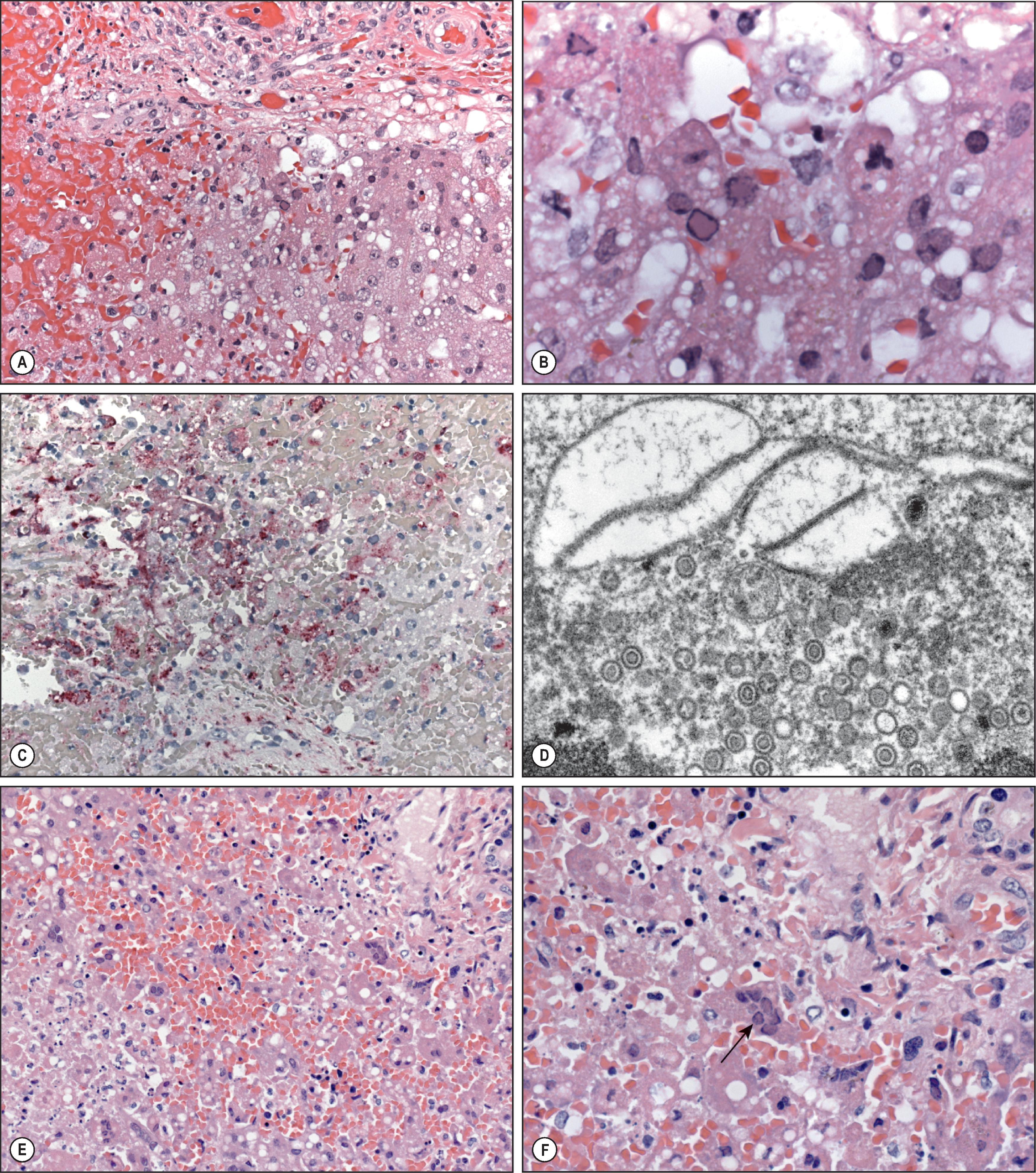
Varicella-zoster virus (VZV) causes chickenpox and, as a reactivation of latent infection, shingles. After infection there is a primary viraemia with viral replication in the epithelium of the gut, respiratory tract, liver, pancreas and adrenal glands. A secondary viraemia leads to skin infection manifested by the classic fluid-filled blisters that form scabs. In adults and children, liver disease is usually restricted to immunocompromised patients. In pregnant women, intrauterine infections can result in severe outcomes (congenital varicella syndrome), and perinatal infections can cause disseminated disease with necrotizing hepatitis. In rare cases, corticosteroid therapy given during the phases of viral dissemination may precipitate severe zoster. We report one such fatal case; a 24-year-old man with a history of asthma developed pneumonia refractory to medical therapy and progression of disease to severe coagulopathy and liver failure. The histopathological manifestations in the liver in severe or fatal infections such as this case resemble those of herpes simplex infections, with focal or massive liver necrosis and minimal inflammation. Intranuclear inclusions may be abundant, as in this case ( Fig. 7.13A, B ), or rare. An immunohistochemical assay targeting VZV shows staining in a membrane and cytoplasmic pattern, confirming the diagnosis ( Fig. 7.13C ). EM shows abundant herpes virions ( Fig. 7.13D ). PCR assays, even when performed on FFPE material, are highly sensitive and specific.
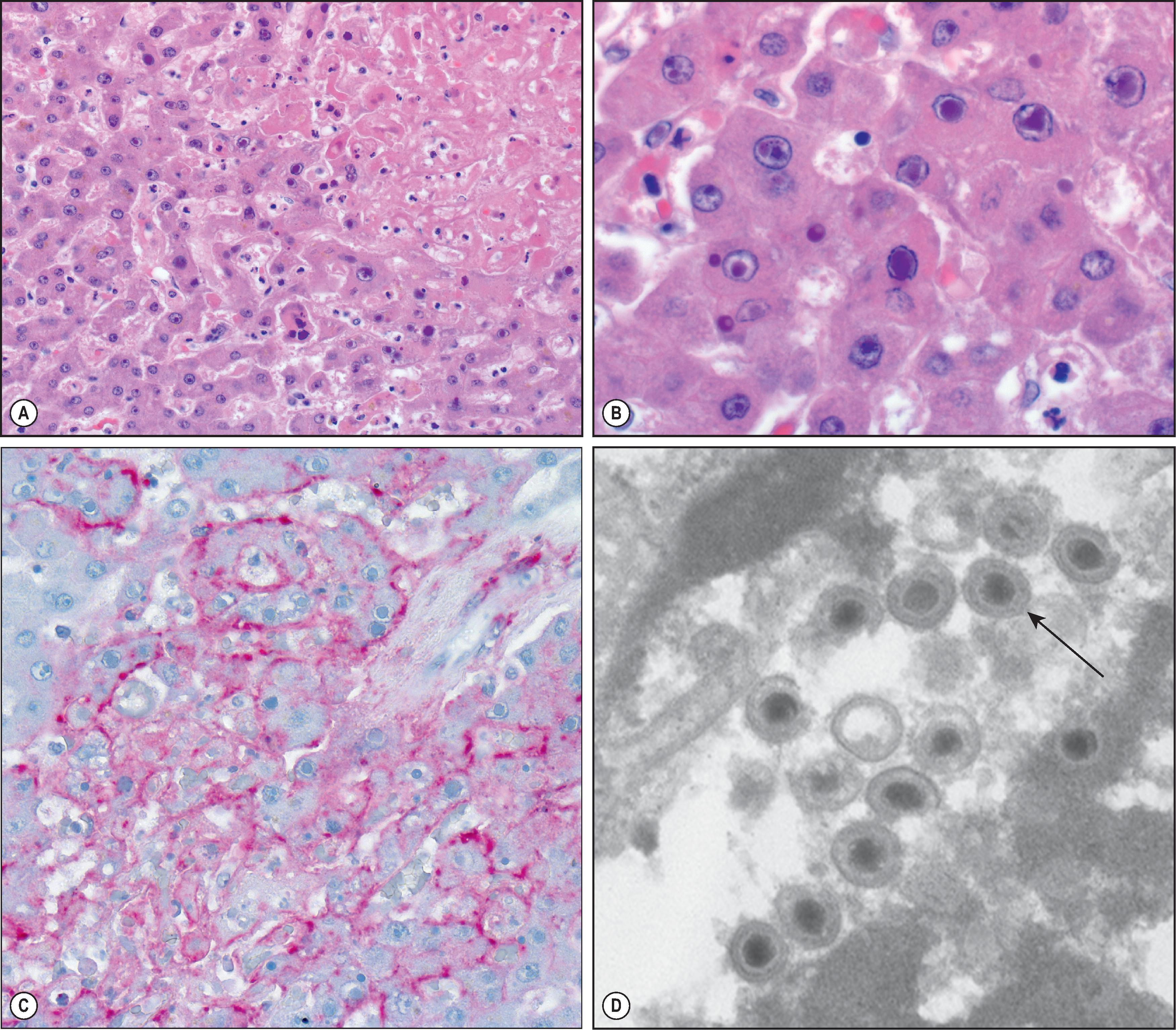
Most adult populations have a prevalence of latent, asymptomatic CMV infection greater than 50%, as judged by serological surveys. Primary infection and clinically significant disease can occur in immunocompetent adults, but the most significant CMV infections occur in infants (as one of the ‘TORCH’ [toxoplasmosis, other agents, rubella, CMV, herpes simplex] infections) and in immunocompromised patients. In renal transplant recipients, CMV is the most common specific cause of hepatitis; in liver transplant recipients, CMV hepatitis needs to be distinguished from graft rejection (see Chapter 14 ).
In immunocompetent individuals, CMV can produce an infectious mononucleosis-like syndrome. Liver biopsy shows focal hepatocyte and bile duct damage with lymphocytic infiltration of the sinusoids. In some cases, noncaseating epithelioid cell granulomas are observed, but viral inclusions or immunohistochemically demonstrable antigen may be absent. ,
CMV is one cause of neonatal hepatitis, with giant cell transformation, cholestasis and inflammation. The characteristic finding is an enlarged cell (endothelial, hepatocyte or bile duct epithelial) with an amphophilic intranuclear inclusion surrounded by a clear halo, resembling an owl’s eye, and basophilic granules in the cytoplasm. Both the nuclear and the cytoplasmic inclusions represent closely packed virions ( Fig. 7.14 ).
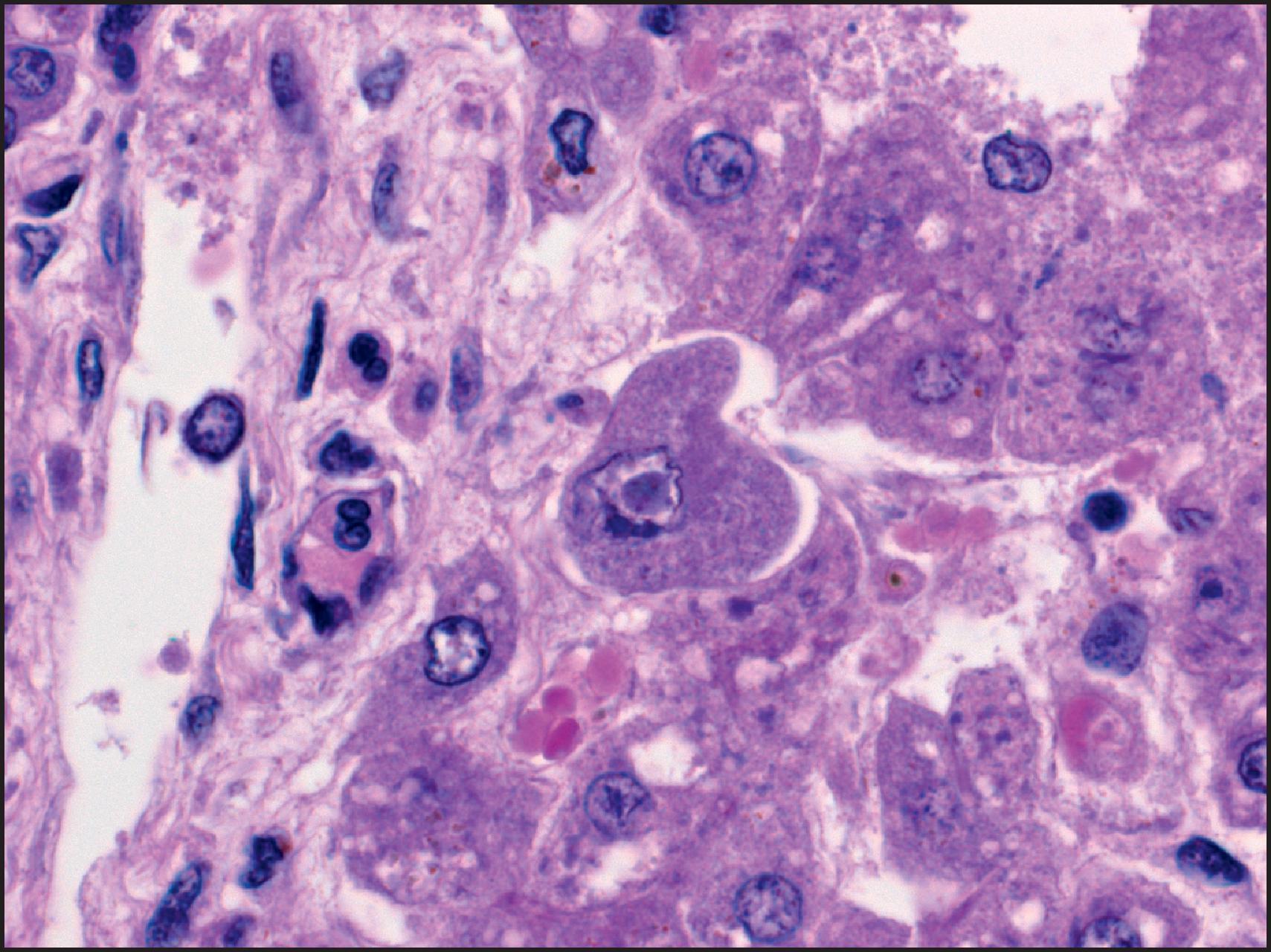
In immunocompromised hosts, CMV inclusions are often seen without necrosis or inflammation—a ‘passenger infection’—but when tissue damage is evident, the virus is presumed to be pathogenic. In the fetal liver, CMV disease has been associated with obliteration of bile ducts, but there is no evidence that it plays a significant role in syndromic or nonsyndromic paucity of intrahepatic bile ducts (see Chapter 3 ).
In the tropics, EBV is transmitted early in childhood and is aetiologically associated with Burkitt lymphoma. In industrialized countries, clinically significant infections usually occur in adolescence or adulthood and cause a self-limited, acute infectious mononucleosis characterized by pharyngitis, fever, rash and cervical lymphadenopathy together with splenomegaly and hepatomegaly in some cases. Transient elevations in transaminase levels occur in the majority of patients, but jaundice is rare. Acute infectious mononucleosis is typically diagnosed clinically, but liver biopsy may be performed in cases with atypical clinical presentations and/or laboratory findings. Histologic sections show expansion of portal tracts by a lymphocyte-predominate inflammatory infiltrate with admixed plasma cells and eosinophils. The sinusoids classically show a diffuse lymphocytic infiltrate arranged in a linear ‘string of beads’ pattern, while the overall lobular architecture is generally preserved. , When the inflammatory infiltrate is marked, endophlebitis is observed, and focal apoptotic hepatocytes (spotty necrosis) can be identified, although fulminant hepatitis is rare. The inflammatory infiltrate is composed predominantly of reactive T lymphocytes and natural killer (NK) cells, whereas EBV-infected B lymphocytes are rare. The sinusoidal lymphocytes can appear atypical, raising suspicion for leukaemia/lymphoma. Larger immunoblastic cells morphologically similar to Hodgkin/Reed–Sternberg (HRS) cells can occasionally be identified and will similarly express CD30, EBV-latent membrane protein and EBV-encoded RNA (EBER); however, unlike in Hodgkin lymphoma, the HRS-like cells in infectious mononucleosis are CD15 negative. , Steatosis may occur in EBV infections, but cholestasis is not a typical feature ( Fig. 7.15C ). Non-necrotizing granulomas and fibrin-ring granulomas are occasionally found in infectious mononucleosis. EBV can be detected in the liver using ISH targeting EBER. The nuclei of infected B lymphocytes are highlighted using this technique, but again, these are rare amid the background of a predominantly T-lymphocyte infiltrate.
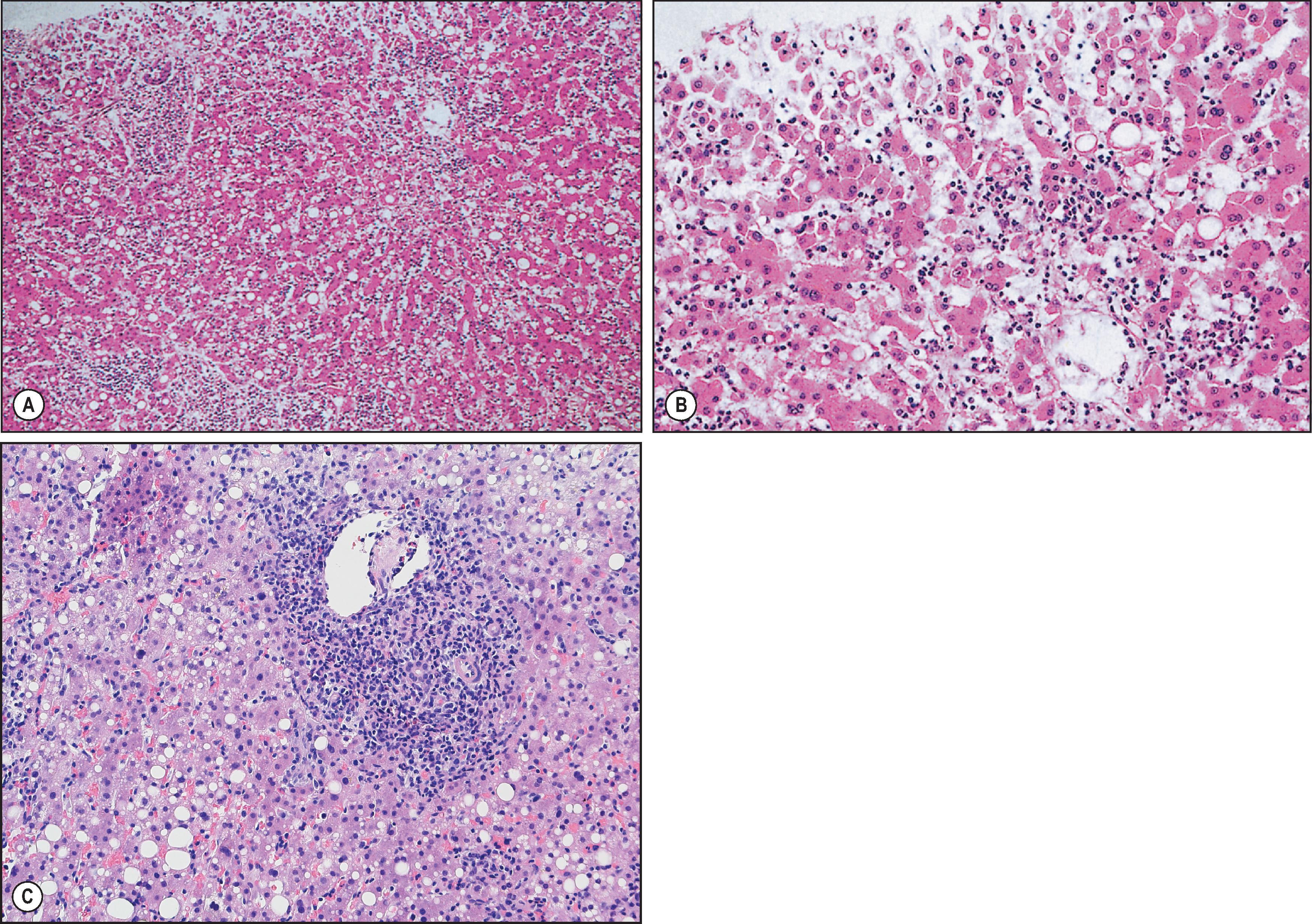
Autoimmune serologies (typically anti-smooth muscle antibody and less commonly antinuclear, mitochondrial, microsomal and reticulin antibodies) can be elevated in patients with EBV hepatitis, raising concern for autoimmune hepatitis. However, the lack of a significant plasma cell infiltrate and the absence of confluent or bridging necrosis, together with EBV viral capsid antigen serologic testing, can help differentiate EBV hepatitis from autoimmune hepatitis.
Unlike EBV, HHV6 infects T cells. Primary infection in children usually causes transient fever and skin rash (erythema subitum). Occasionally, severe visceral infection can result, including hepatitis and haemophagocytic syndrome. This can occur in transplant recipients and other immunosuppressed patients (including those with HIV/AIDS) and occasionally in immunocompetent persons. The histopathology is of a nonspecific lobular hepatitis. Syncytial giant cell transformation of bile ductular epithelium has been described in a heart transplant recipient.
The DNA adenoviruses usually affect the respiratory tract and conjunctiva. In children and in adults immunosuppressed due to HIV infection, severe combined immunodeficiency, haematological malignancy or organ transplantation, adenovirus may cause a severe hepatitis and liver failure. The pathological features are similar to those of HSV infection. There are extensive areas of liver cell necrosis with minimal inflammation; intranuclear inclusions may be abundant ( Fig. 7.16 ).
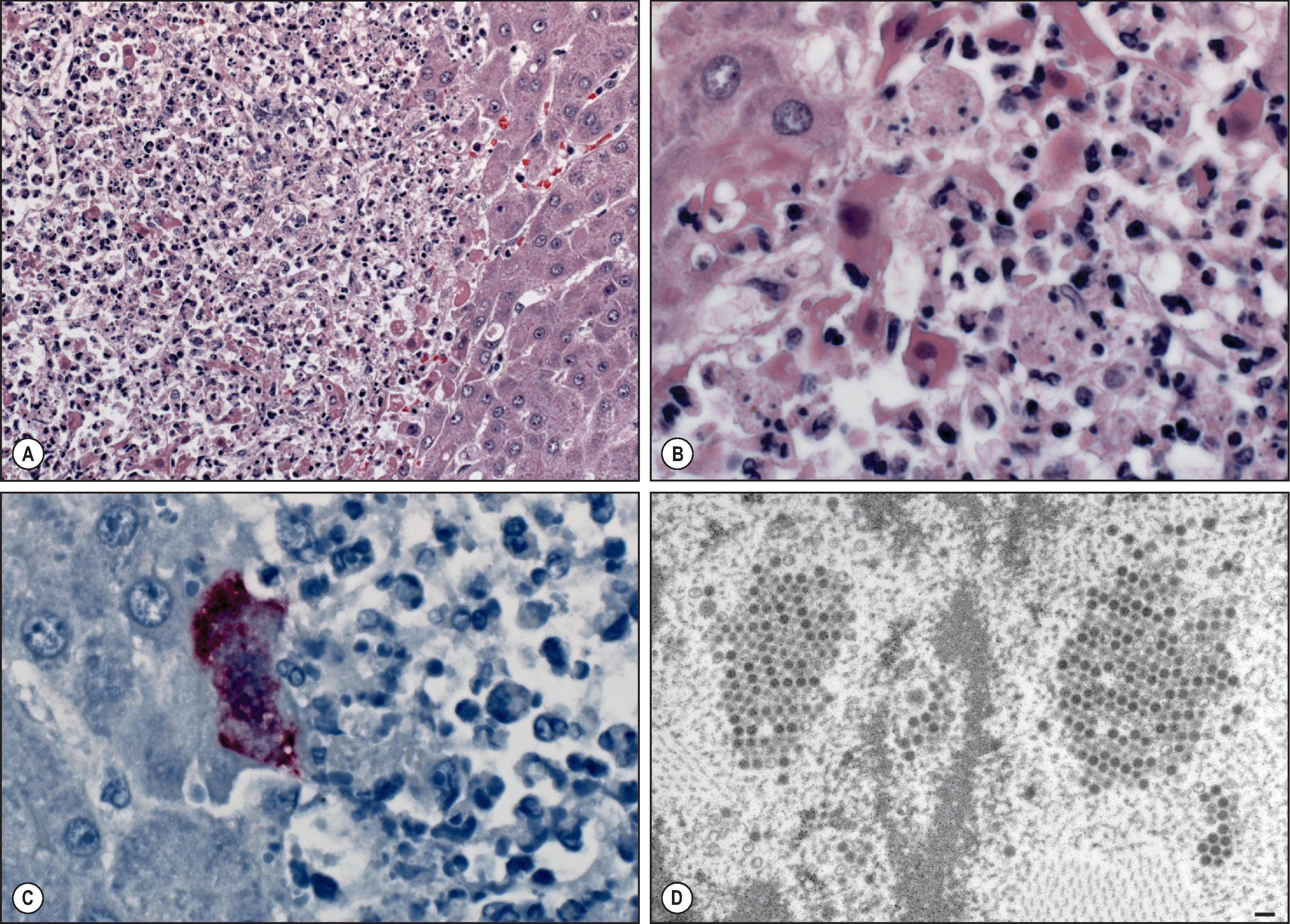
Human parvovirus B19 is the aetiological agent of erythema infectiosum in childhood. The infection can be transmitted during pregnancy to the fetus and can cause nonimmune hydrops fetalis. The virus infects erythroid progenitor cells and causes damage to many fetal organs. Morphological features in the liver include cholestasis, hepatocyte swelling and variable necrosis. There is excessive erythropoietic activity, and viral inclusions can be identified in erythroid cells (‘lantern cells’) , ( Fig. 7.17 ). In children, parvovirus B19 can be associated with active hepatitis and may be a cause of fulminant liver failure.
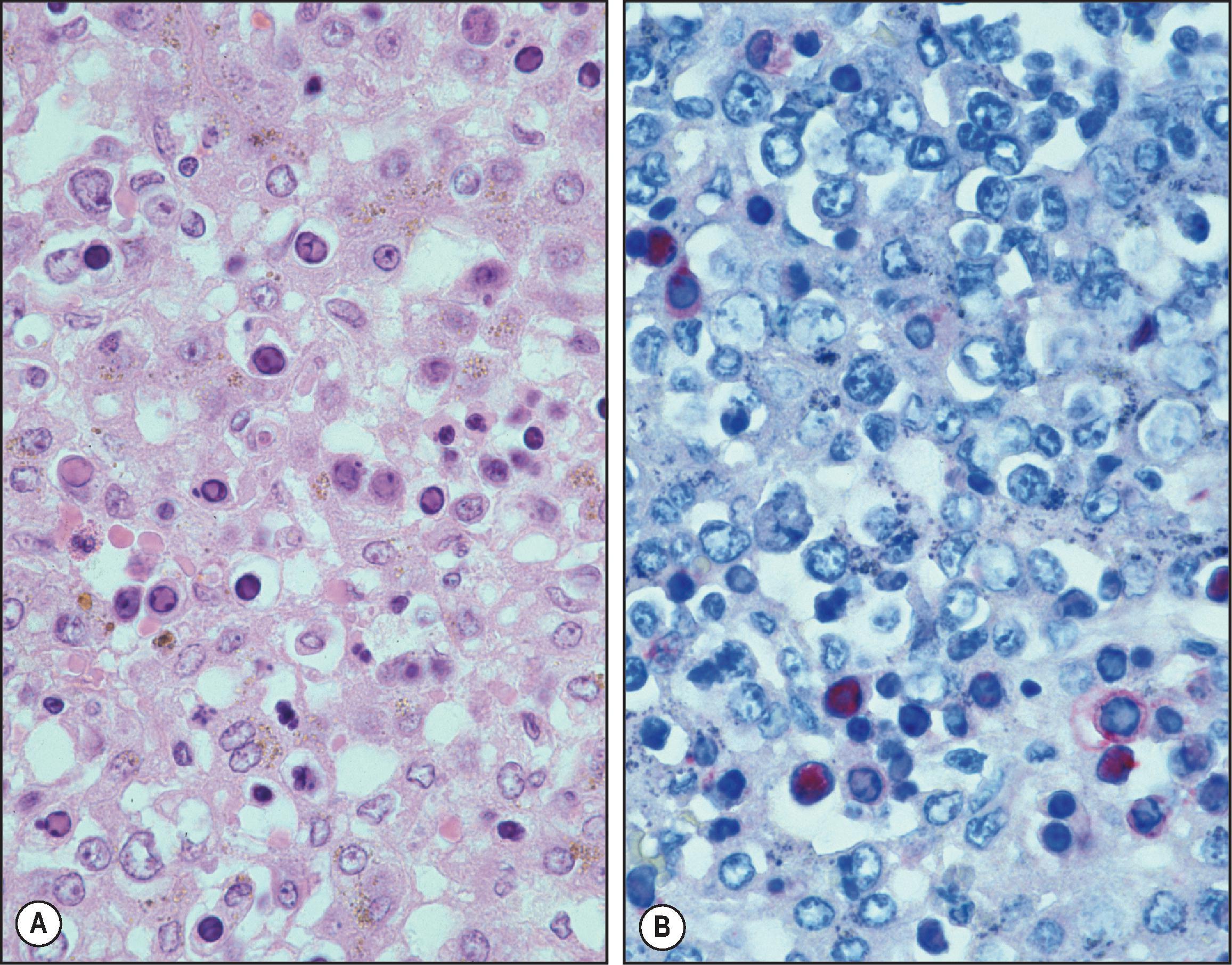
Rabies lyssavirus , formerly Rabies virus (family Rhabdoviridae , genus Lyssavirus ), causes acute encephalitis that is almost uniformly fatal in unvaccinated hosts. Typically, rabies is transmitted through infected saliva from a bite or close contact with a rabid animal, such as dogs or bats. Rabies is seldom included in the differential diagnosis of encephalitis in the absence of a documented exposure or suggestive history. Rabies has been reported in solid-organ transplant recipients from infected donors. , Symptoms of fever, hydrophobia, changes in mental status and autonomic instability are suggestive of infection. The postmortem diagnosis of rabies can be made by examination of CNS tissues. Lymphohistiocytic infiltrates and microglial nodules involving the cerebrum, brainstem, cerebellum and spinal cord are seen in fatal cases. Typical eosinophilic intracytoplasmic inclusions (Negri bodies) within neurons are characteristic. Rabies is a systemic illness also involving the peripheral nerves in various tissues, including the liver and kidney. Lymphohistiocytic infiltrates surrounding the large nerves within connective tissue of the liver can be seen in some cases ( Fig. 7.18A ). Immunohistochemical assays reveal abundant antigens within involved nerves in such cases ( Fig. 7.18B ). Matrices of the ribonucleoprotein, along with rhabdovirus particles form the Negri bodies, can be seen by EM ( Fig. 7.18C ).
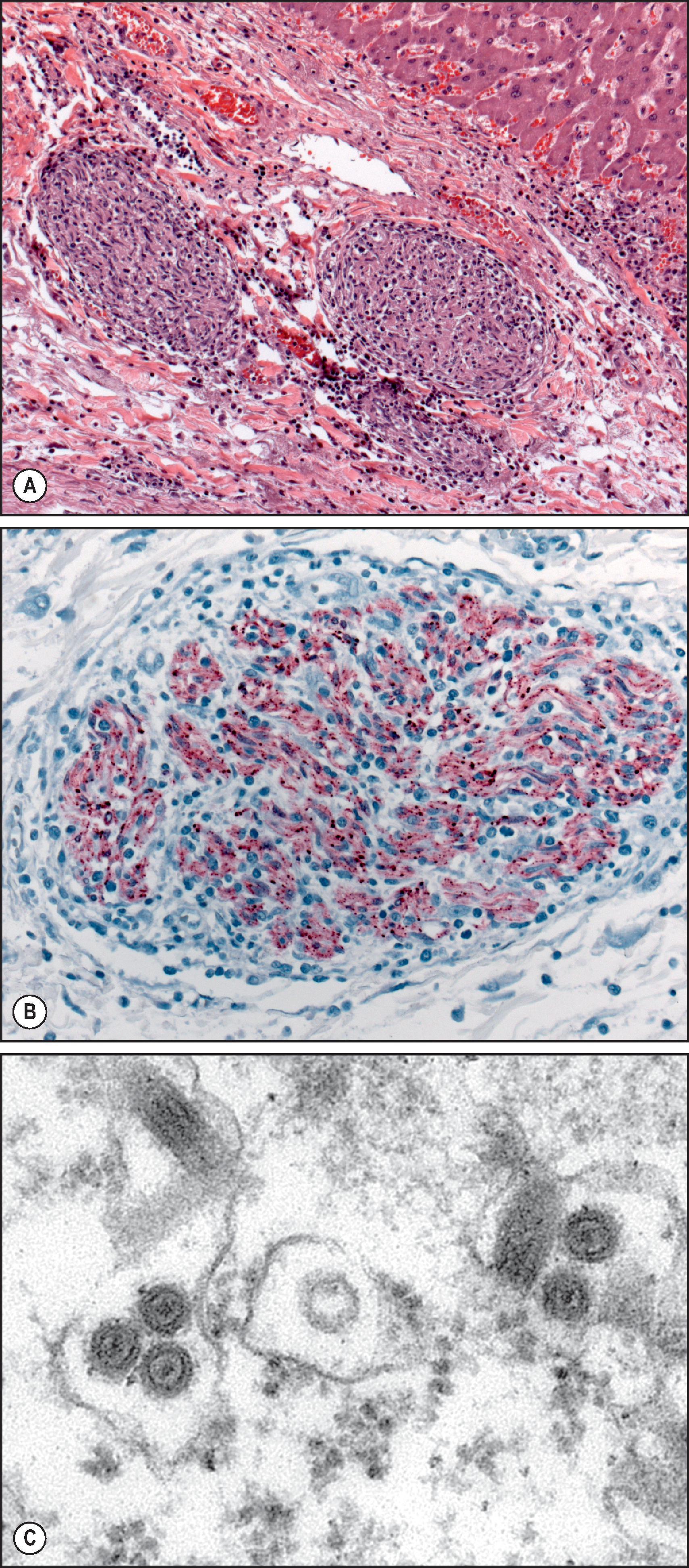
Rickettsiae are obligate intracellular parasites that contain both DNA and RNA. They are coccobacilli, 0.3 µm in size, and in human infections are found in endothelial cells. Although mild derangement of liver function tests (LFTs) may occur in any of the rickettsial fevers, including typhus, clinically significant liver disease is seen in Q fever, Boutonneuse fever, Rocky Mountain spotted fever and bacillary angiomatosis.
Coxiella burnetii is the aetiological agent of Q fever and exists as a zoonosis in domestic and other animals. Transmission to humans is probably by inhalation, with a resulting rickettsemia. Clinical presentations include pneumonia, hepatitis and fever of unknown origin. LFTs are usually abnormal. The typical microscopic hepatic lesions are ring or intraparenchymal granulomas. Fibrin-ring granulomas have a central fat vacuole, bordered by activated macrophages with an entrapped intermediate ring of fibrin ( Fig. 7.19 ). Nonvacuolated granulomas and tuberculoid granulomas with giant cells and central necrosis may also occur. Thus, the histolopathological differential diagnosis also includes brucellosis and tuberculosis (TB).
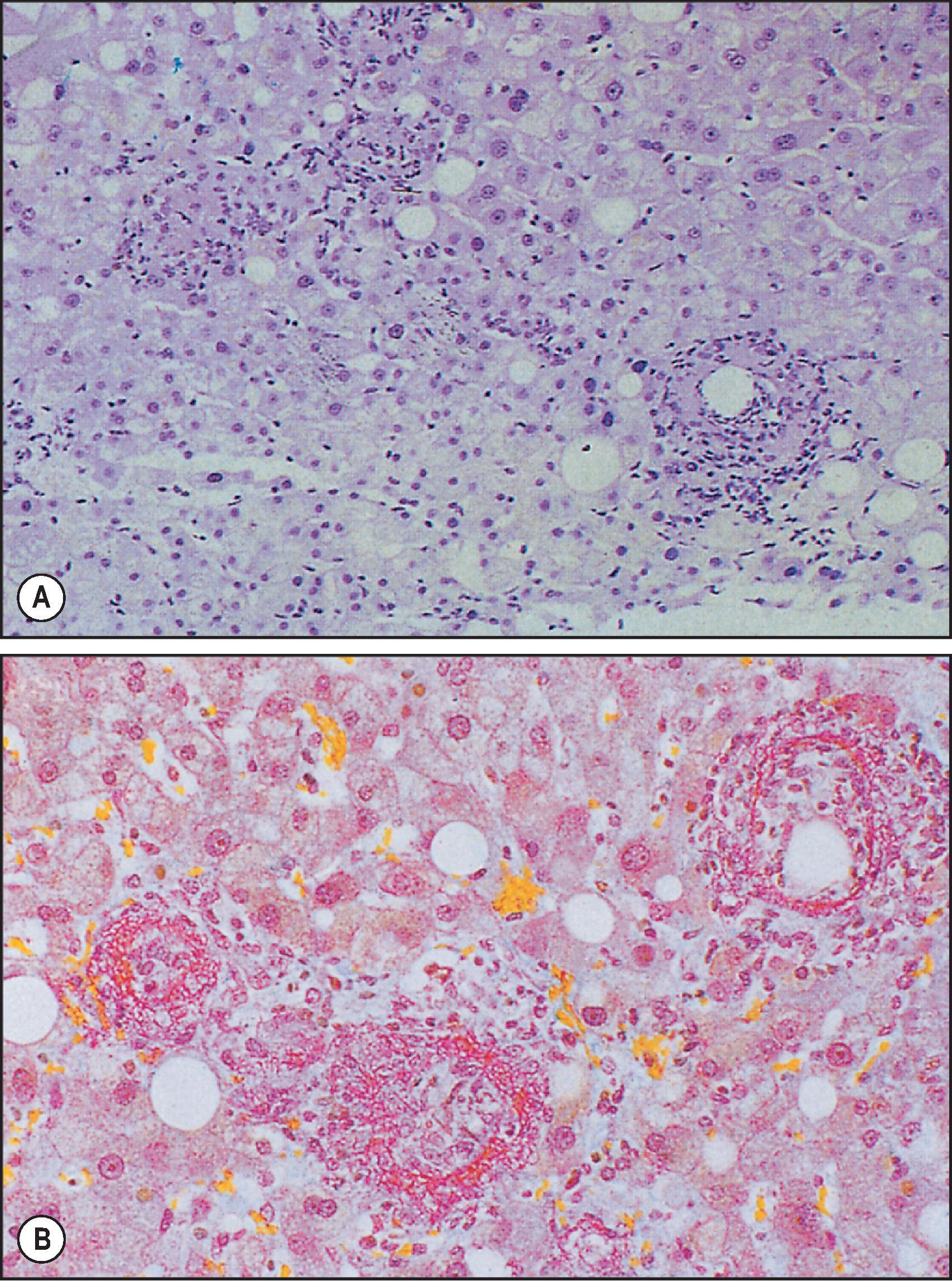
Of note, the fibrin-ring granuloma is not specific for Q fever and can also be seen in patients with lymphoma, staphylococcal bacteraemia, EBV infection, CMV infection, leishmaniasis and allopurinol hypersensitivity, among other etiologies. ,
The tick-borne infection Rickettsia conorii (Mediterranean spotted fever) occurs in the Mediterranean basin, in East and South Africa and in India. Once thought to have a benign clinical course, the disease is now considered as severe a disease as Rocky Mountain spotted fever, with mortality as high as 32% according to some studies. , Clinical symptoms are similar to those of other rickettsial infections and include fever, headache and maculopapular rash; an eschar forms at the site of the tick bite. The liver lesions have been described as ‘granulomatous’, similar to those in Q fever. A series of liver biopsies from boutonneuse fever patients without clinical signs of liver disease showed multifocal hepatocyte necrosis and mononuclear inflammation; no granulomas were observed, and portal tracts were unremarkable. Immunohistochemical assays can demonstrate rickettsial antigens in endothelial cells lining the sinusoids.
Rickettsia is the causative agent of Rocky Mountain spotted fever, a seasonal tick-borne infection that occurs in the Americas. Hepatitis is part of the Rocky Mountain spotted fever syndrome. As with R. conorii infection, the primary target of infection is the endothelial cell. The portal tracts are inflamed, with mononuclear and neutrophilic perivascular inflammation and vasculitis (predominantly mononuclear) ( Fig. 7.20A ). Fibrin thrombi may form over damaged portal endothelial cells. Erythrophagocytosis by Kupffer cells may be prominent, but there is no significant hepatocyte necrosis or cholestasis. IHC demonstrates the rickettsial antigen within endothelial cells and Kupffer cells ( Fig. 7.20B ).
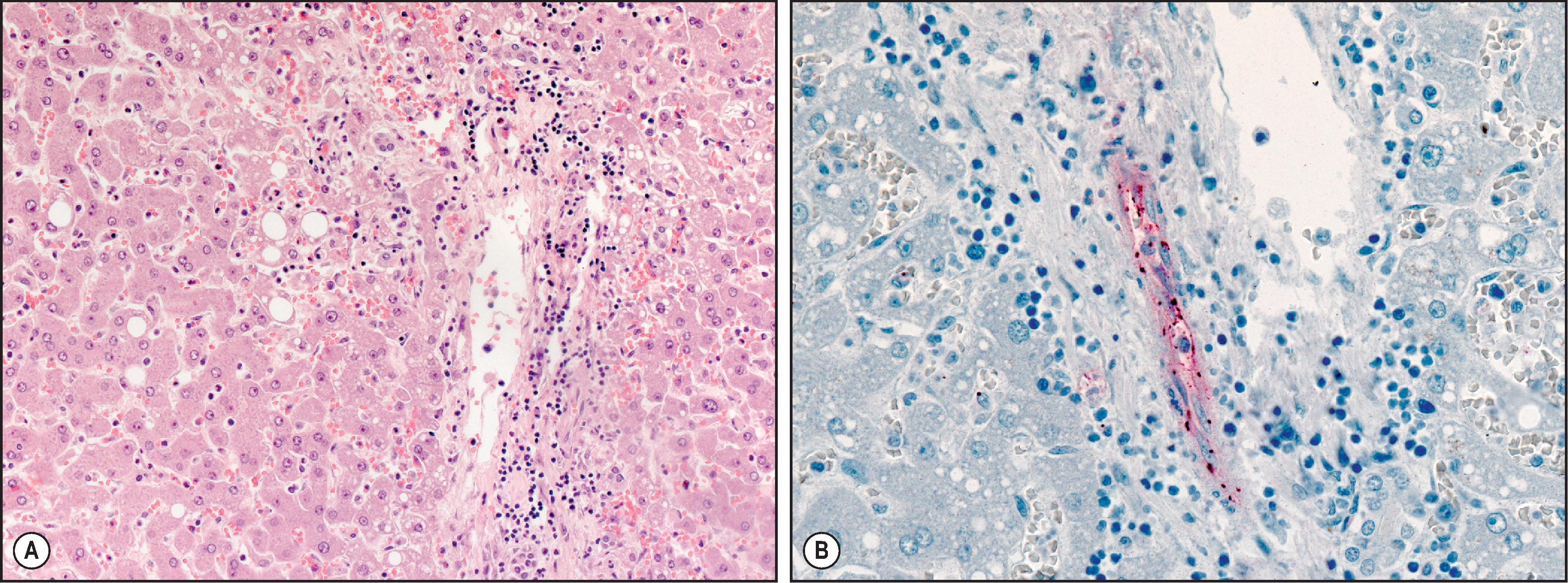
Chlamydiae are obligate intracellular parasites that contain both RNA and DNA and have a characteristic life cycle with inclusion bodies. The liver is involved in two chlamydial diseases: psittacosis and genital infection. Infection with Chlamydia psittaci causes pneumonia and systemic illness with hepatomegaly and sometimes jaundice. Focal hepatocyte necrosis and Kupffer cell hypertrophy have been described in autopsy material. The intracellular inclusion bodies are difficult to identify, even with a Giemsa stain. Genital tract infection with Chlamydia trachomatis causes salpingitis and may produce the Fitz–Hugh–Curtis syndrome of perihepatitis.
Ehrlichiosis is a tick-borne zoonosis caused most frequently by Ehrlichia chaffeensis , which is related to Rickettsia . Most reported cases occur in the United States. The syndrome of human monocytic ehrlichiosis is a mild to severe, febrile multisystem illness. The liver pathology has been described : there is lobular hepatitis with variable hepatocyte injury and death, Kupffer cell hyperplasia, hepatic granulomas and cholestasis ( Fig. 7.21A ). These obligate intracellular bacteria are extremely difficult to resolve with routine histological techniques; however, these techniques are not specific or sensitive ( Fig. 7.21B ). With immunocytochemistry and ISH, the intracytoplasmic inclusion bodies may be seen in lobular or portal mononuclear cells and in the peripheral blood monocytes ( Fig. 7.21C ) and also can be visualized by EM ( Fig. 7.21D ).
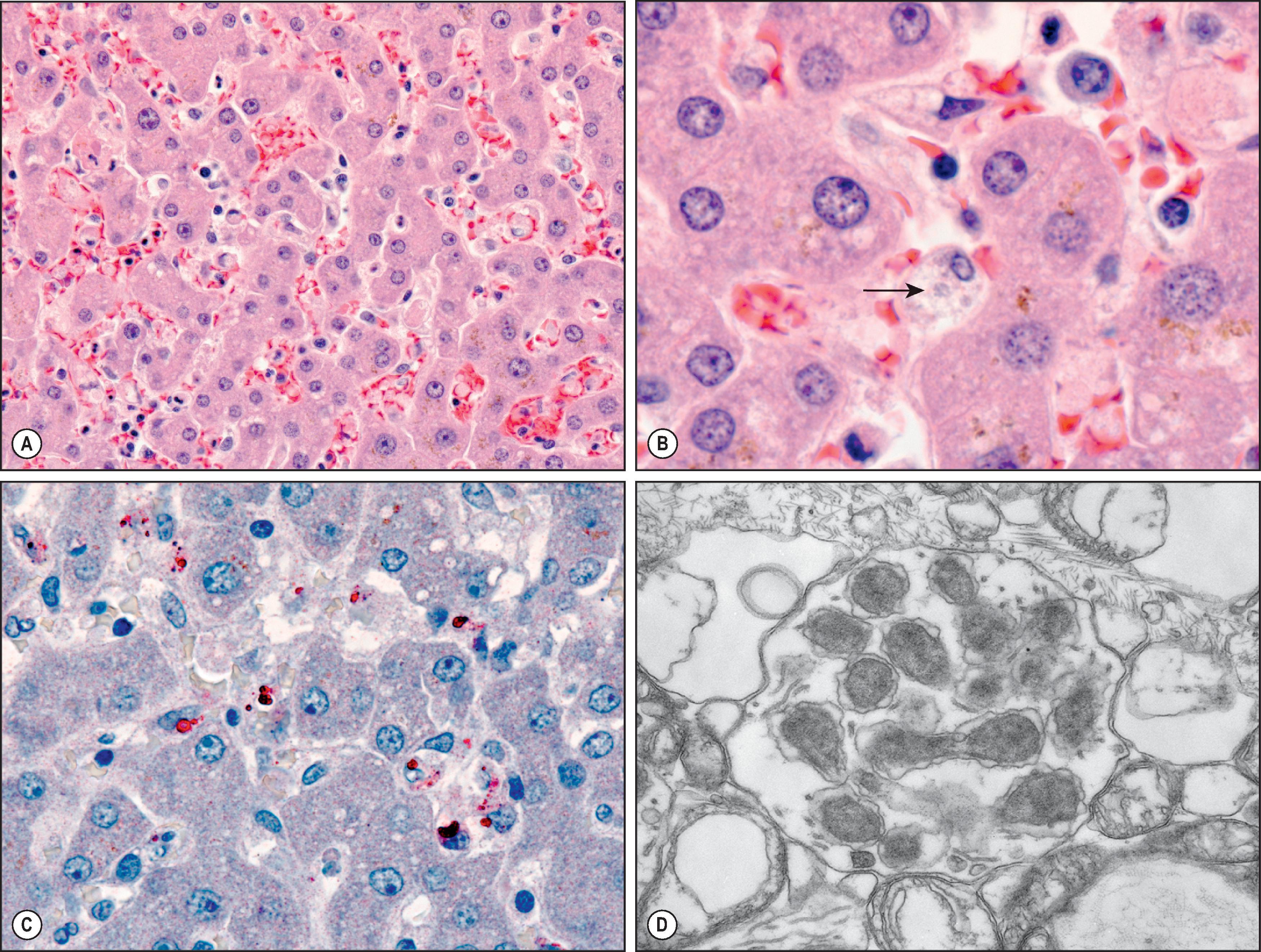
Hepatomegaly and jaundice are frequently associated with septicaemia, i.e. bacteraemia with clinical shock. Various histological features can be observed in the liver depending on the aetiology and severity of the condition. Canalicular cholestasis is common, sometimes with inspissated bile in cholangioles (‘ductular cholestasis’). This has been referred to as cholangitis lenta . Steatosis and perivenular ischaemic necrosis are nonspecific but often observed. Microabscesses may occur throughout the parenchyma and contain visible bacteria.
Bacterial infection may reach the liver through the portal vein, hepatic artery and biliary tree, resulting in septic portal thrombophlebitis and hepatic abscesses. Sources of sepsis include the appendix, colon and pancreas. In some developing countries, a significant proportion of idiopathic splenomegaly has been attributed to a late complication of neonatal portal pyaemia and secondary splenic vein occlusion that originated from umbilical sepsis.
Hepatic arterial spread of infection is common, but patients often succumb before visible abscesses can develop. One of the more frequent identifiable lesions is seen in staphylococcal sepsis: clusters of Gram-positive cocci surrounded by necrosis and neutrophils. In chronic granulomatous disease (see Chapter 3 ), disseminated bacterial infection (usually staphylococcal) also involves the liver ; portal macrophages with lipofuscin pigment, parenchymal necrotizing granulomas and portal fibrosis are seen. In septicaemia caused by Neisseria gonorrhoeae , jaundice is a common complication, with focal necrosis and neutrophil infiltration in the liver. Liver tenderness described as ‘perihepatitis’ can complicate pelvic infection by gonococci and C. trachomatis (the Fitz–Hugh–Curtis syndrome) and may simulate acute cholecystitis. , The liver parenchyma is normal in this condition, but the organisms can be isolated from the capsule. Septicaemia and fatal infections caused by group A streptococci are often found at autopsy. In the liver, Kupffer cell hyperplasia, sinusoidal bacteria and neutrophilic inflammation can be seen ( Fig. 7.22A ). Gram stains can be used to visualize the Gram-positive bacteria in the sinusoids ( Fig. 7.22B ); however, it is considerably less sensitive and specific than IHC and PCR assays ( Fig. 7.22C ) because of phagocytosis and degradation of the cell wall by bacterial enzymes. Other Gram-positive bacteria such as Streptococcus pneumoniae and Staphylococcus aureus should also be included in the differential diagnosis.
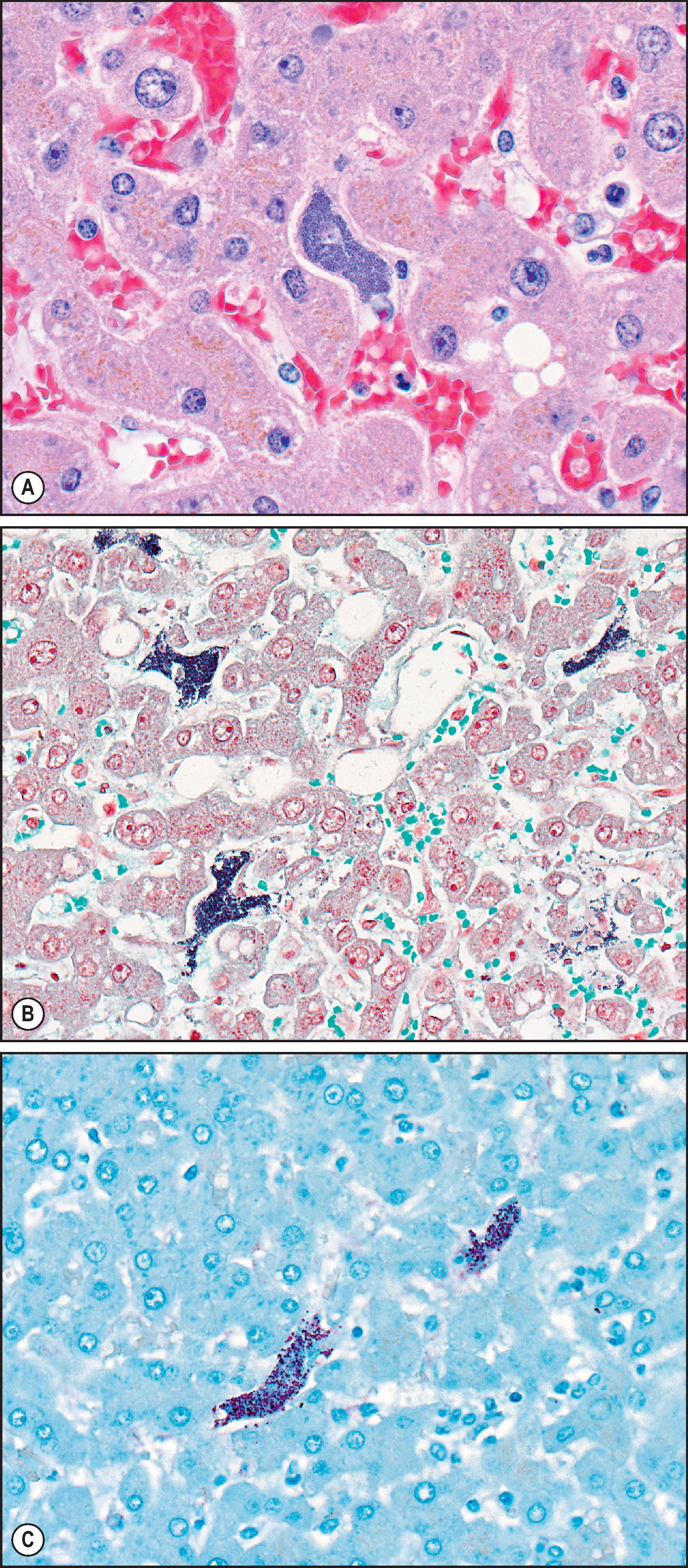
Fusobacterium species are Gram-negative, filamentous, anaerobic bacteria that colonize the oropharynx but can cause tonsillar abscesses and other head and neck infections. Lemierre syndrome (postanginal sepsis) is a classic complication of infection by Fusobacterium necrophorum , characterized by thrombophlebitis of the internal jugular vein and septicaemia. Septic emboli to the liver can cause often multiple liver abscesses. The diagnosis is suggested by the morphological features on Gram stain and further confirmed by IHC and PCR assays performed on FFPE tissue ( Fig. 7.23 ).
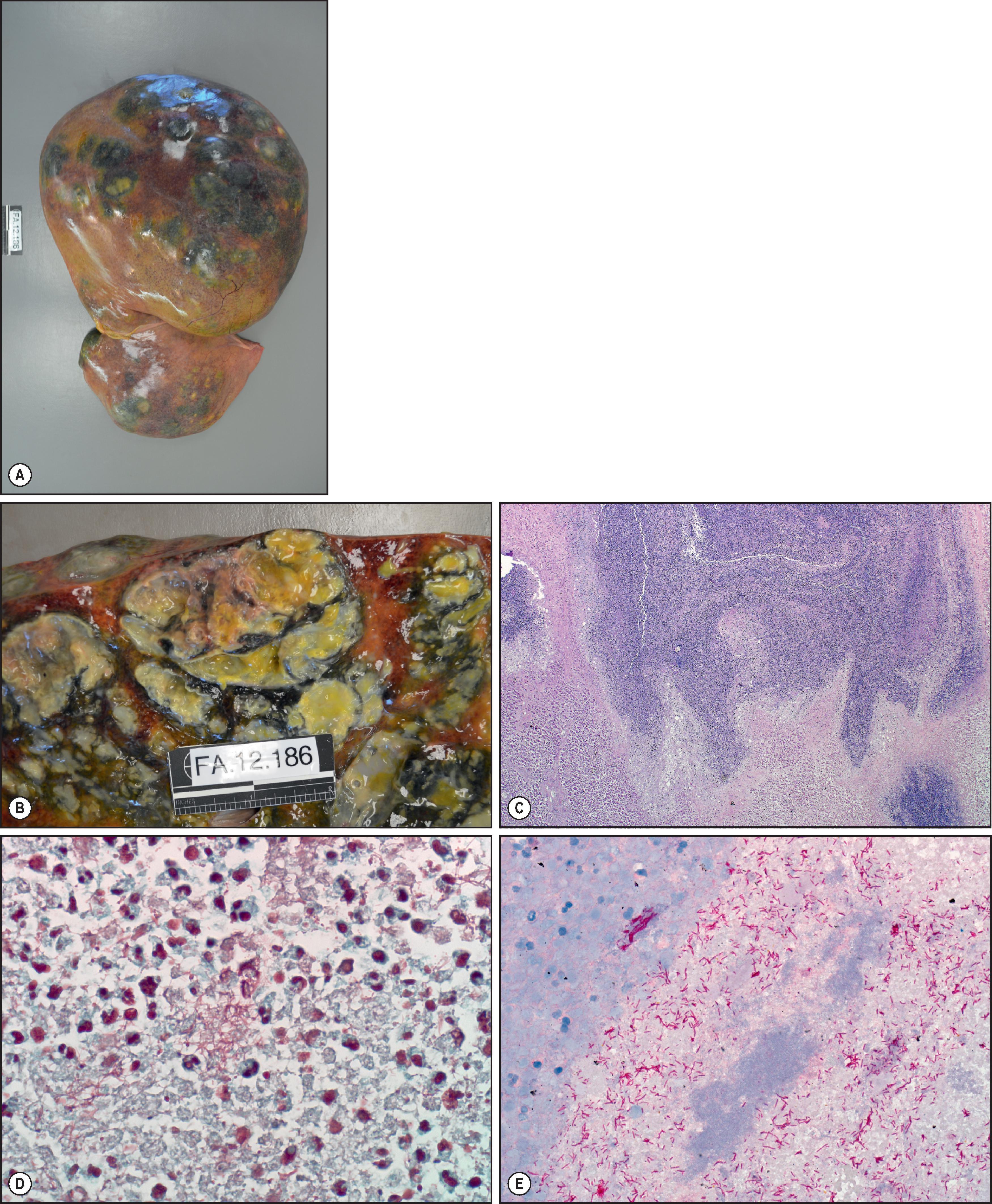
Septicaemic plague, caused by Yersinia pestis (Gram-negative coccobacillus), is a highly virulent infection. The liver shows fibrin thrombi, multiple necrotic foci and numerous short, Gram-negative rods with minimal inflammatory response. The diagnosis can be confirmed using IHC and PCR assays , ( Fig. 7.24 ). Yersinia enterocolitica infection is more common; a global food-borne infection, it causes enteritis and mesenteric adenitis with characteristic purulent granulomas and can occasionally affect the liver, usually through bacteraemia. The liver lesions include granulomas and large, pyogenic abscesses. Of note is the growth-potentiating role of iron for Yersinia ; multiple liver abscesses have led to the diagnosis of underlying haemochromatosis.
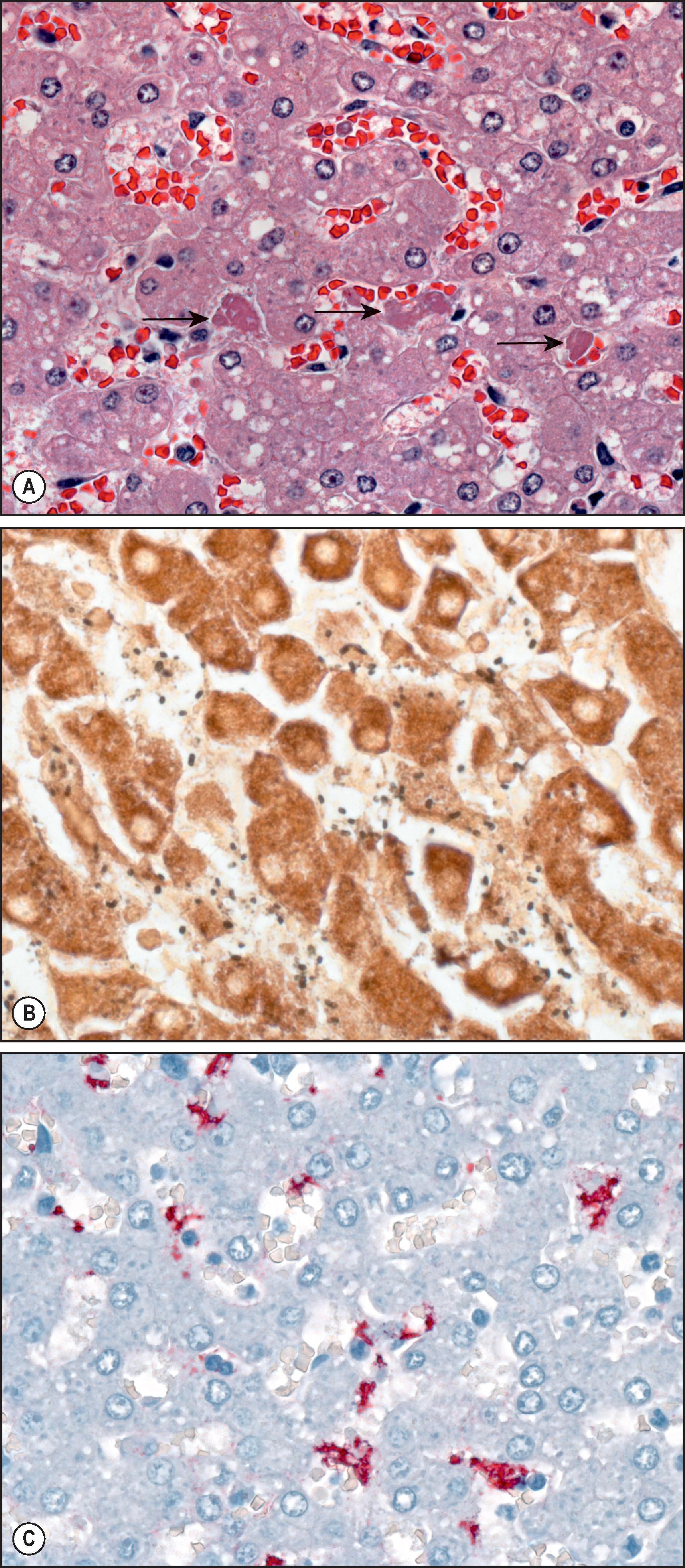
Other, relatively uncommon bacterial infections that can cause septicaemia include Francisella tularensis, Bacillus anthracis, Streptobacillus moniliformis and Capnocytophaga spp.
Tularaemia is a zoonotic disease caused by F. tularensis . Ulceroglandular tularaemia is the most common clinical presentation, accounting for about 70–80% of cases, and is characterized by cutaneous lesions accompanied by enlarged, draining lymph nodes. Typhoidal tularaemia accounts for about 10–15% of infections and can be complicated by sepsis with no lymphadenopathy. Septicaemia can cause widespread necrosis in tissues, including the liver. Necrotic granulomas can be observed in such cases, and special stains are often noncontributory. IHC and PCR assays are extremely helpful in confirming the diagnosis ( Fig. 7.25 ).

Anthrax is caused by B. anthracis , a Gram-positive endospore-forming bacterium that can cause fatal infections in livestock and humans. Most frequently, animals become infected after contact with soil-borne spores, the ultimate reservoir of B. anthracis. There are several clinical forms of disease, depending on the route of infection; humans are infected through direct skin contact with infected animals or animal products (cutaneous), ingestion of contaminated meat (gastrointestinal) or inhalation of spores (inhalational). Infections occur when spores enter the body from the external environment; direct human-to-human transmission of anthrax is not known to occur. Traditionally, B. anthracis is suspected when Gram-positive bacilli are observed by examination of smears of body fluids or tissue section. The liver is usually involved as part of the septicaemia, and Gram-positive bacilli can be seen without significant inflammation , ( Fig. 7.26 ).
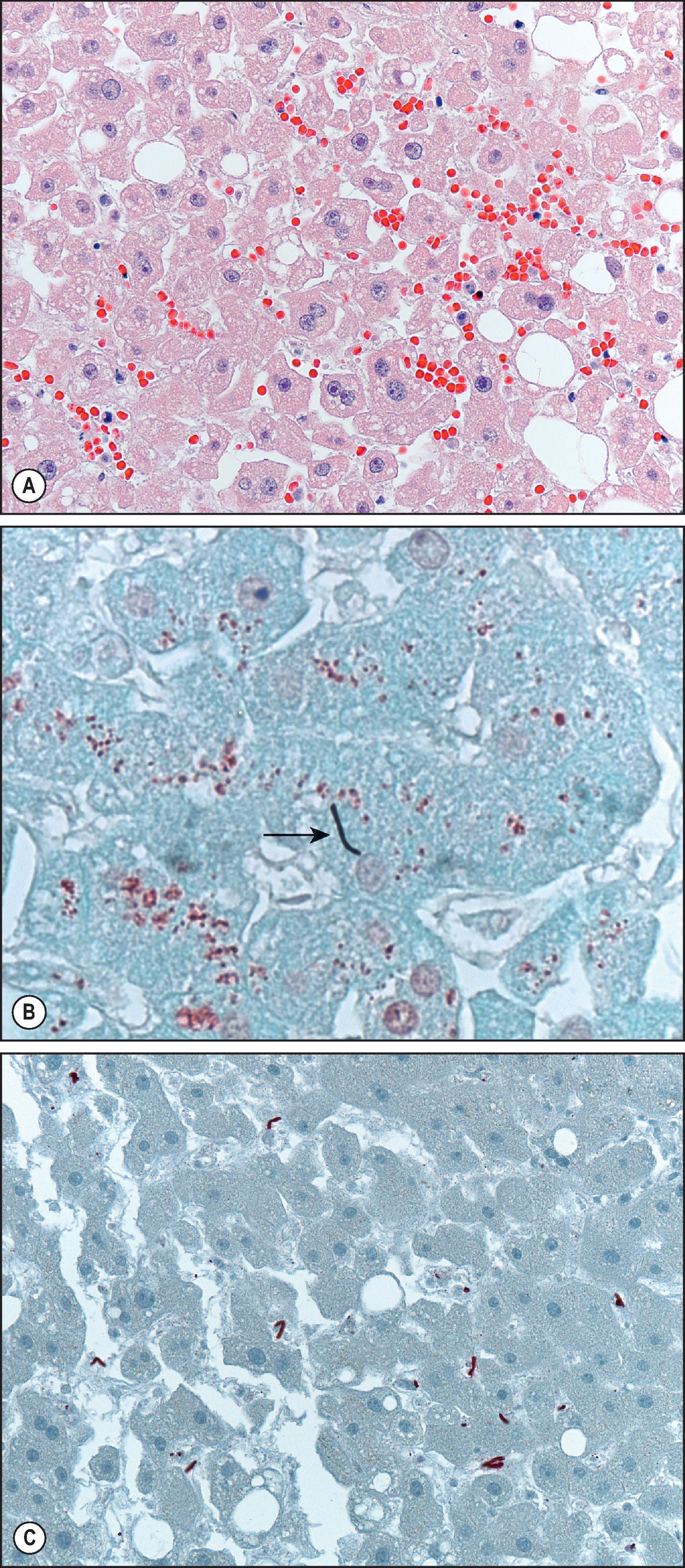
Rat-bite fever is a systemic and sometimes fatal disease that typically presents with fever and rigor, skin rash and migratory polyarthralgias. S. moniliformis is the causative agent of rat-bite fever in North America, whereas infections in Asia (also called ‘sodoku’) are attributed to Spirillum minus . The bacterial organisms colonize the nasopharynx of rodents and can be transmitted to humans through a bite. Pathology in the liver is nonspecific, but erythrophagocytosis is often seen. Special stains, particularly silver stains, are useful in demonstrating clumps of bacilli in liver sinusoids. ISH and PCR can be used to confirm the diagnosis ( Fig. 7.27 ).
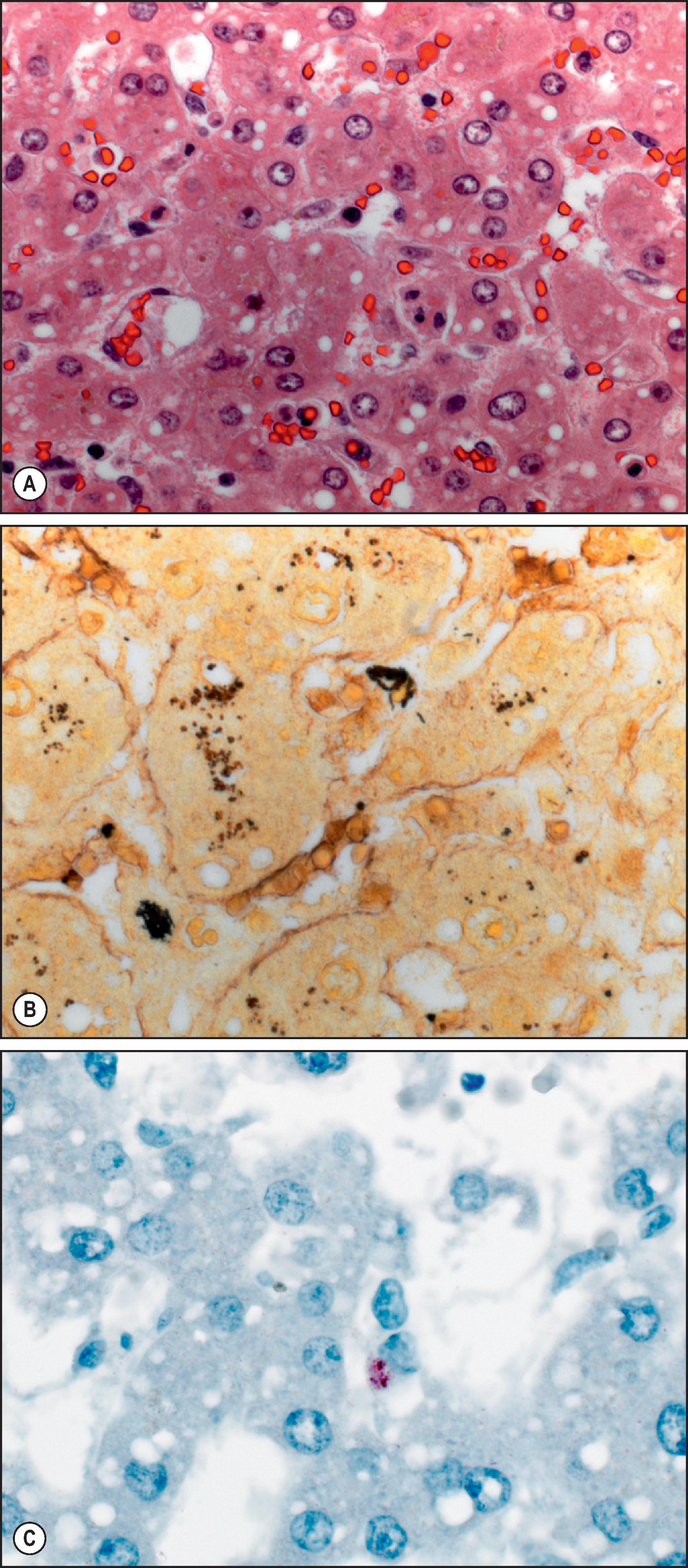
The Capnocytophaga genus consists of eight species. All are common to human and canine flora, but only Capnocytophaga canimorsus causes severe infections in humans. C. canimorsus was first isolated in 1976 from the blood and spinal fluid of a dog-bite patient and later became known as the ‘dog-bite organism’. C. canimorsus is an oropharyngeal commensal organism in dogs and cats but can cause a spectrum of infections, from cellulitis to meningitis and endocarditis, in humans. Patients with severe manifestations may develop septic shock that can progress to multiorgan failure and death. Histopathological features include focal hepatic necrosis with an acute inflammatory reaction. Special stains and molecular methods including PCR are extremely helpful in the diagnosis ( Fig. 7.28 ).
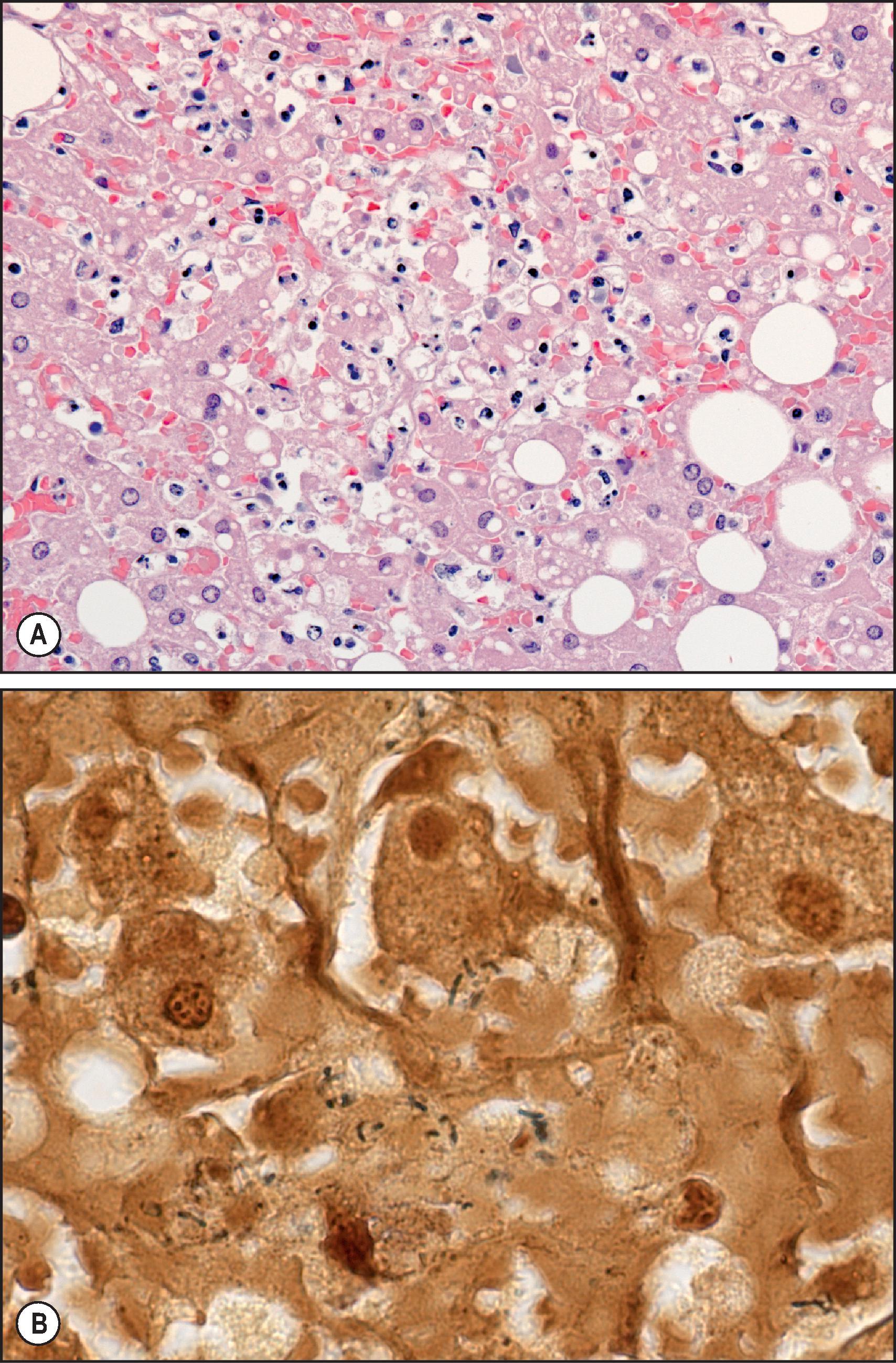
The spread of a bacterial infection throughout the liver can also occur from the biliary tree after an acute ascending cholangitis (see Chapter 9 ). This often complicates large-duct obstruction caused by stones but may follow suppurative cholecystitis, postoperative biliary strictures, acute or chronic pancreatitis and tumours in the biliary tree or pancreas. In many cases of pyogenic liver abscess, the origin of the infection is not obvious. Underlying diseases and conditions (e.g. diabetes mellitus, perforated duodenal ulcer, diverticular disease) can increase susceptibility to such infections. The most common aetiological agents include Escherichia coli and other coliforms, but anaerobes are also reported. Streptococcus milleri is also common. The differential diagnosis of pyogenic liver abscess includes amoebiasis and several worm infections of the biliary tree that predispose the patient to bacterial cholangitis (ascariasis, clonorchiasis, fascioliasis).
This group of infections shares clinicopathological features; they are intracellular parasites of macrophages, and all may cause granulomatous hepatitis.
Salmonella typhi is a Gram-negative bacillus. The classic clinicopathological phases of typhoid disease are incubation, active invasion (dissemination throughout the lymphoreticular system), fastigium and lysis. During the phase of invasion, the liver shows a range of nonspecific histological lesions: sinusoidal and portal lymphocytosis, focal parenchymal necrosis and Kupffer cell hypertrophy, sometimes with erythrophagocytosis. Small macrophage clusters, which evolve into non-necrotizing epithelioid cell granulomas, are often seen. Small-droplet macrovesicular steatosis in hepatocytes is common. In the symptomatic phase of fastigium, there is hepatomegaly and sometimes jaundice. The granulomas in the liver enlarge and become necrotic, as they do in the lymph nodes of the bowel and mesentery ( Fig. 7.29 ). There are no Langhans giant cells, and bacilli are very difficult to detect with standard methods such as Gram stain. Although typhoid bacilli multiply readily in the bile and gallbladder, ascending cholangitis is rare.
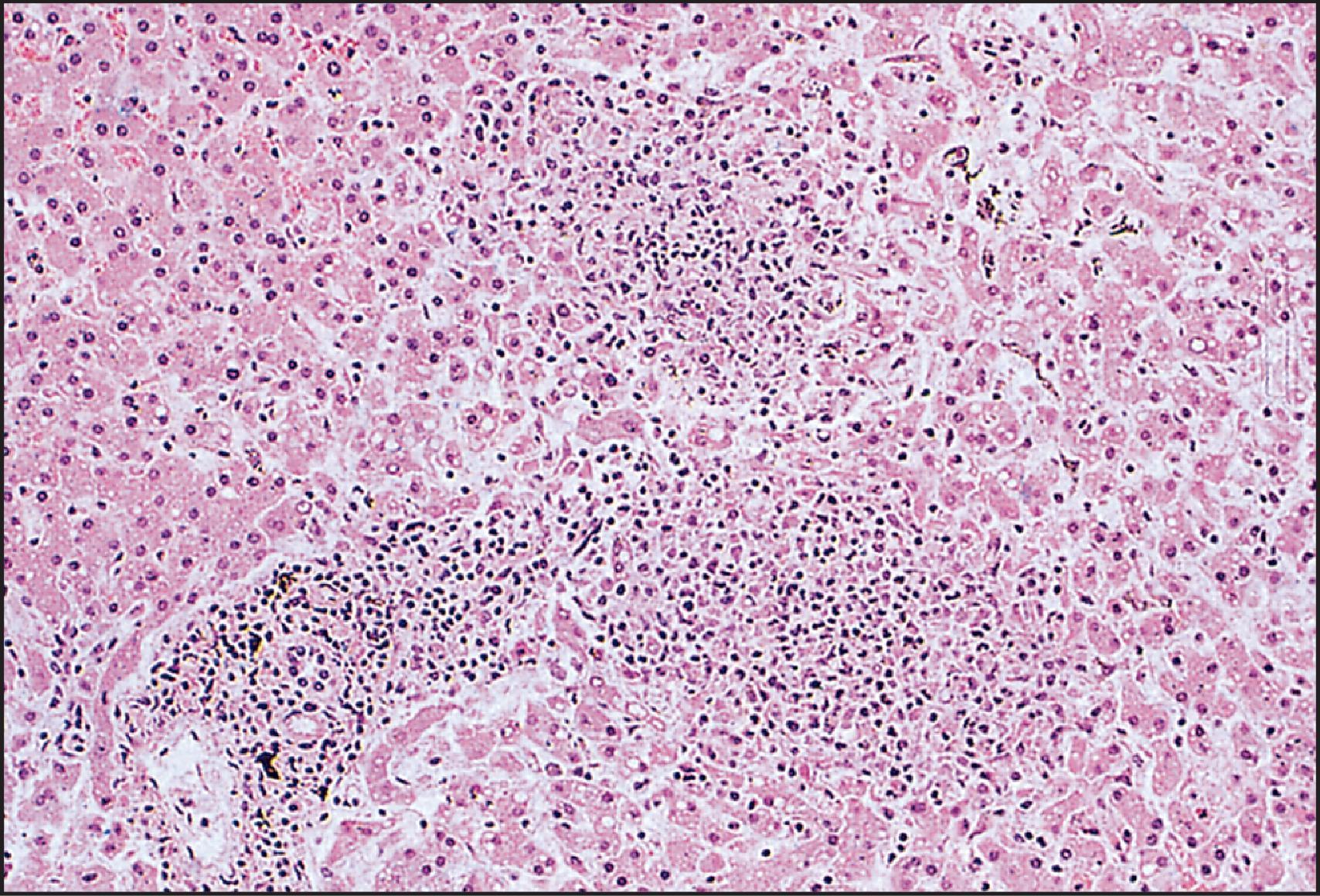
Brucellosis is a zoonosis of ruminants caused by Brucella melitensis , Brucella abortus or Brucella suis . Humans may become infected by the Gram-negative bacilli from occupational exposure or ingestion of unpasteurized milk products. The clinical manifestations are protean; brucellosis is a great mimic. The three main clinical patterns, acute, recurrent and chronic, all include fever and weakness. In all patterns, there is haematogenous dissemination of bacteria to lymphoreticular organs, including the liver. Hepatomegaly and altered LFTs are common.
Histological examination shows a nonspecific reactive hepatitis with microgranulomas or epithelioid cell granulomas in portal areas and throughout the lobules , ( Fig. 7.30 ). The latter may have giant cells and in the chronic pattern of brucellosis, there may be fibrinoid necrosis, rendering the histological appearance indistinguishable from TB or histoplasmosis. Necrosis is uncommon, and cholestasis is not typically seen. Patients with large caseous granulomas (‘coin lesions’) in the liver have been reported. When granulomatous hepatitis without evident cause is encountered in biopsy material, brucellosis should always be considered. Serological testing is the means of establishing the diagnosis.

Disease caused by the Gram-negative bacillus Burkholderia (formerly Pseudomonas ) pseudomallei is endemic in Southeast Asia and the Indian subcontinent, and sporadic cases occur in other parts of the tropics and subtropics (although not in Africa). , The organism is a saprophyte of soil and water. Clinically, melioidosis presents as acute pulmonary, septicaemic or chronic suppurative disease. The acute infections are rapid and have high mortality; hepatomegaly and jaundice are features. In acute melioidosis, the liver shows small and large abscesses, the rods of which may be seen on silver stain ( Fig. 7.31 ). In chronic melioidosis, necrotic granulomas may mimic TB or may be stellate in form, resembling cat-scratch disease. Bacteria are rarely seen.
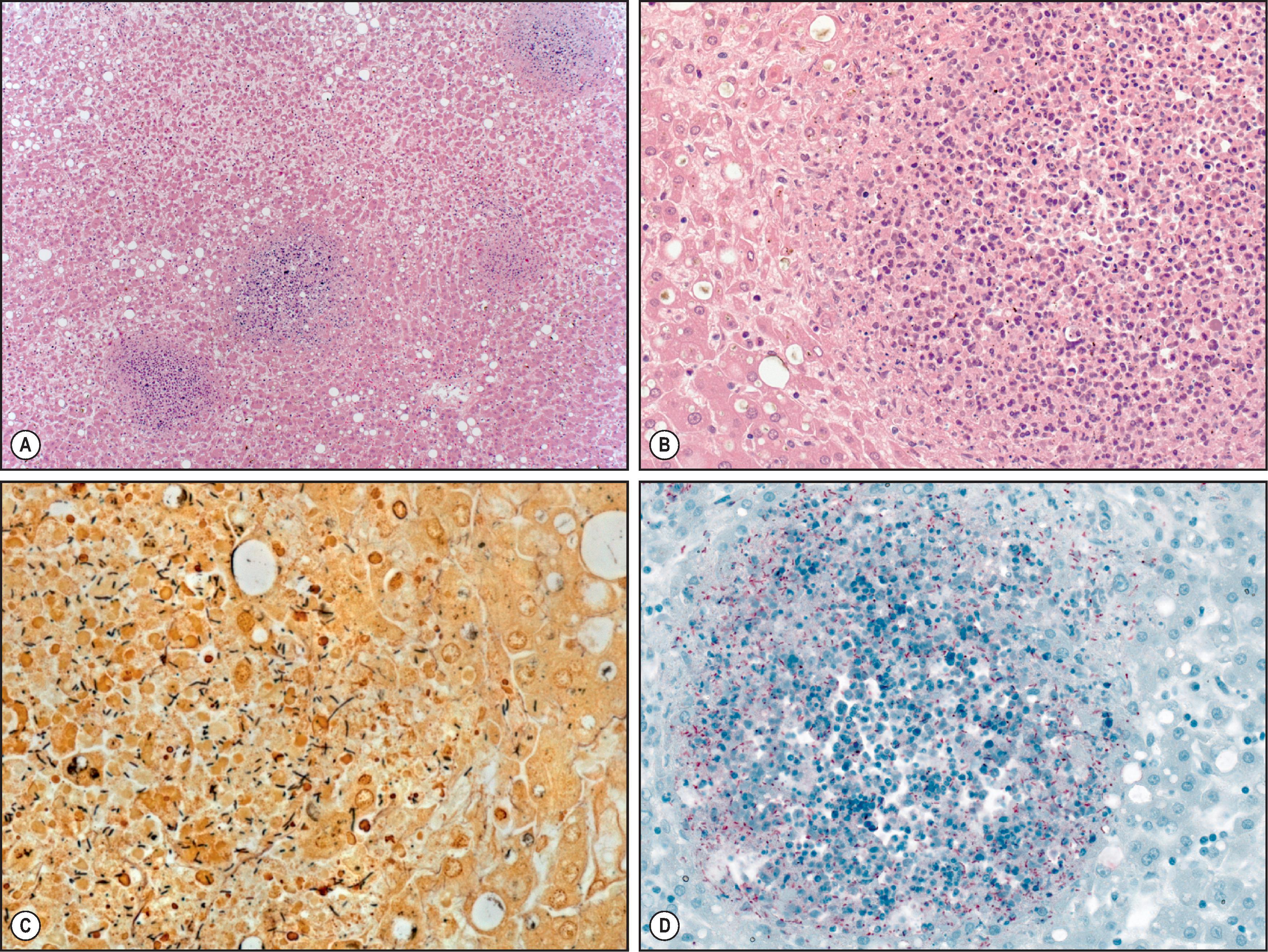
Listeria monocytogenes is a Gram-positive bacillus that is saprophytic in soil and water. It may be transmitted to humans through the consumption of contaminated foods such as soft cheeses. Disease occurs in pregnant women and their infants by the transplacental route, in immunosuppressed patients and less often in immunocompetent individuals. HIV infection does not play a predisposing role. The clinical disease in neonates is septicaemia with multiple organ lesions. The liver shows miliary microabscesses that contain abundant Gram-positive rods ( Fig. 7.32 ). In routine sections, this may resemble acute neonatal syphilis. In adults with listeriosis the clinical picture can mimic viral hepatitis, although microabscesses with bacilli are common, and some patients have a granulomatous hepatitis.
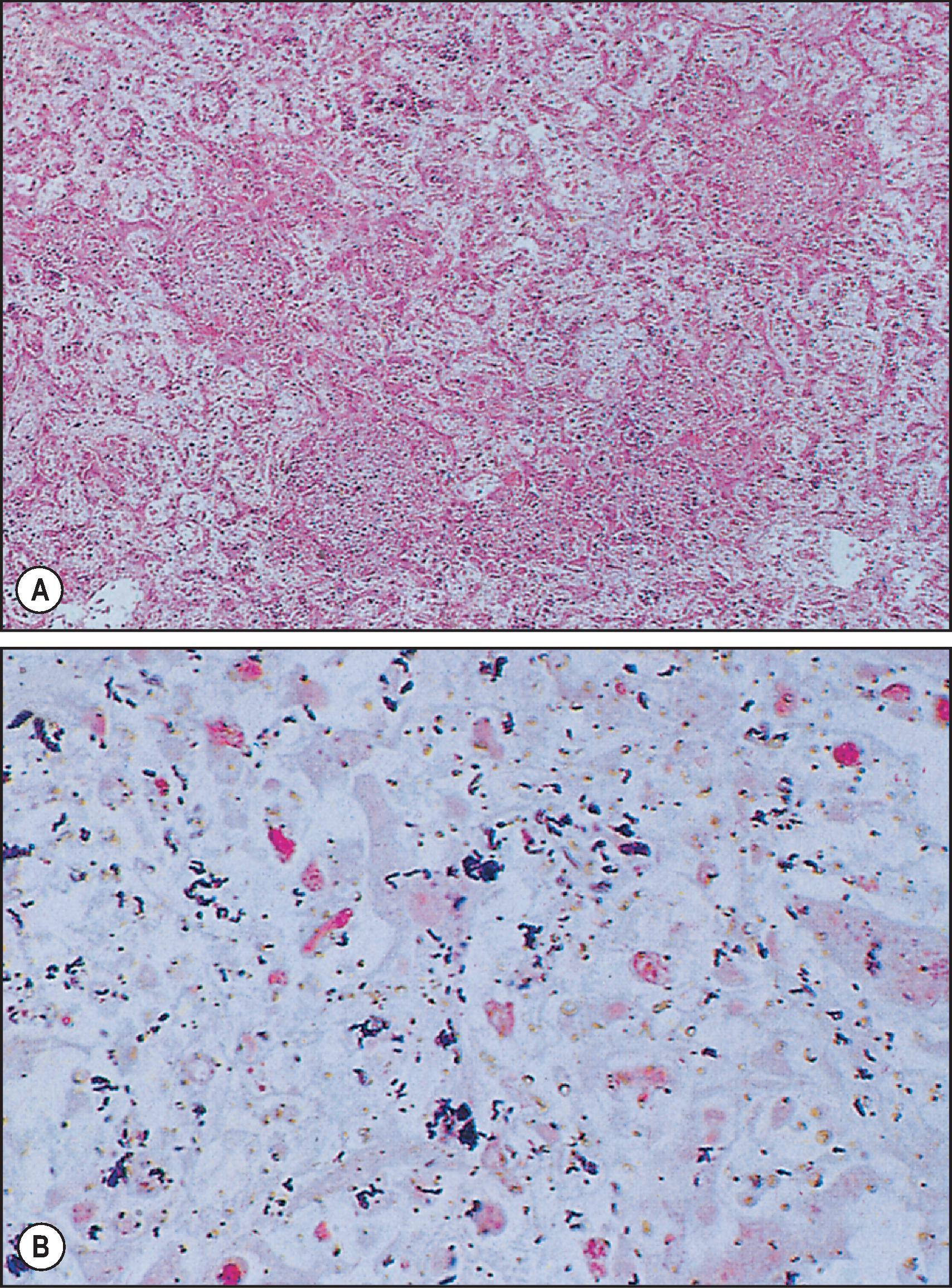
Tropheryma whipplei (formerly Tropheryma whippelii ) is the causative organism of Whipple disease and is mentioned here with bacterial agents that have similar pathological features; this disease is also described in Chapter 15 . Whipple disease is rare, occurring at a prevalence of 9.8 cases per 1 million individuals in the United States. Although historically considered a disease more common in men, Whipple disease has been show to affect men and women at similar rates in the United States, while in Germany, the disease has a higher prevalence in women. The most common manifestations include weight loss, abdominal pain and diarrhoea. Cardiac involvement can lead to sudden death, and CNS involvement may result in dementia, epilepsy or abnormal involuntary movements.
Microscopically, the features of Whipple disease in the liver on low-power microscopy may initially appear unimpressive, with sinusoidal congestion and scant portal and lobular inflammation ( Fig. 7.33A ). However, closer examination of the sinusoids reveals Kupffer cells with distinct, blue-tinged intracytoplasmic contents ( Fig. 7.33B, C ), which can be highlighted using a periodic acid-Schiff (PAS) stain after diastase digestion ( Fig. 7.33D ). An immunohistochemical assay specifically targeting T. whipplei demonstrates the distribution of the bacteria throughout Kupffer cells lining the sinusoids and in portal-based macrophages ( Fig. 7.33E ).
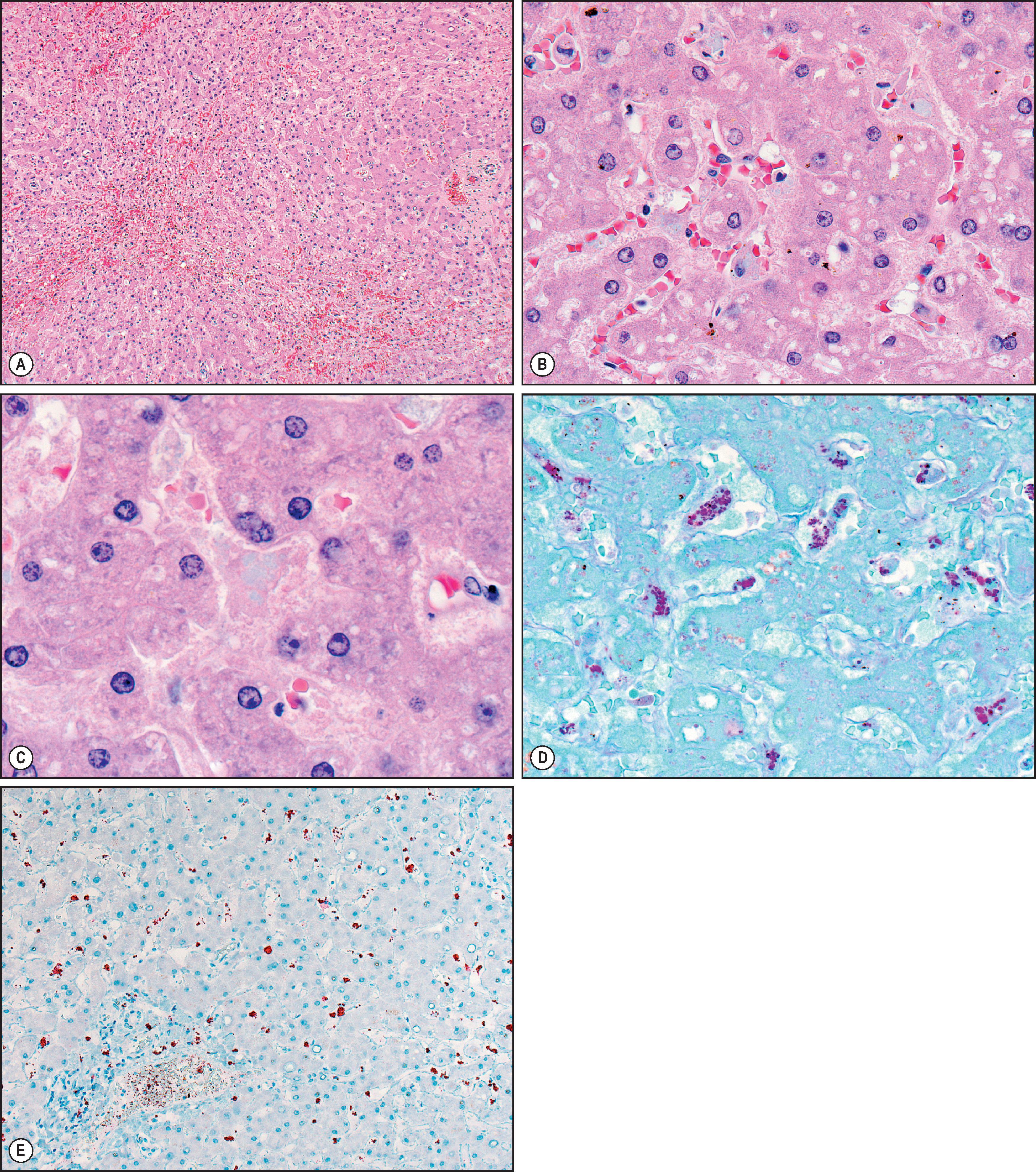
Advances in bacterial taxonomy have clarified and unified a complex group of unusual diseases. Bartonella henselae and less often Bartonella quintana are the aetiological agents of cat-scratch disease, bacillary peliosis (including peliosis) and bacillary angiomatosis, as well as trench foot and some cases of endocarditis. Although most cases of cat-scratch disease manifest only as a skin lesion and local lymphadenopathy, dissemination to the viscera, including the liver, occurs in a small proportion. Occasionally this can occur without lymphadenopathy.
Severe anaemia is a hallmark of Oroya fever, the febrile phase of Carrión disease (bartonellosis), caused by Bartonella bacilliformis , and it has also been described in infections by B. henselae . This bacterium is also implicated in cryptogenic hepatitis, bacillary peliosis hepatitis, granulomatous hepatitis and microabscesses in the liver.
The liver lesions have the same histological appearance as infected lymph nodes with stellate microabscesses that have a granulomatous border ( Fig. 7.34A ). With Warthin–Starry stain, extracellular clumps of short, Gram-negative bacilli may be demonstrated at the edges of the necrosis. Immunohistochemical assays can highlight the bacteria in areas of granulomatous inflammation ( Fig. 7.34B ). Peliosis hepatis occurs mainly in immunocompromised patients (e.g. those with HIV/AIDS) and in many cases is caused by Bartonella infection (see later discussion). It also may develop in transplant patients taking immunosuppressive drugs.
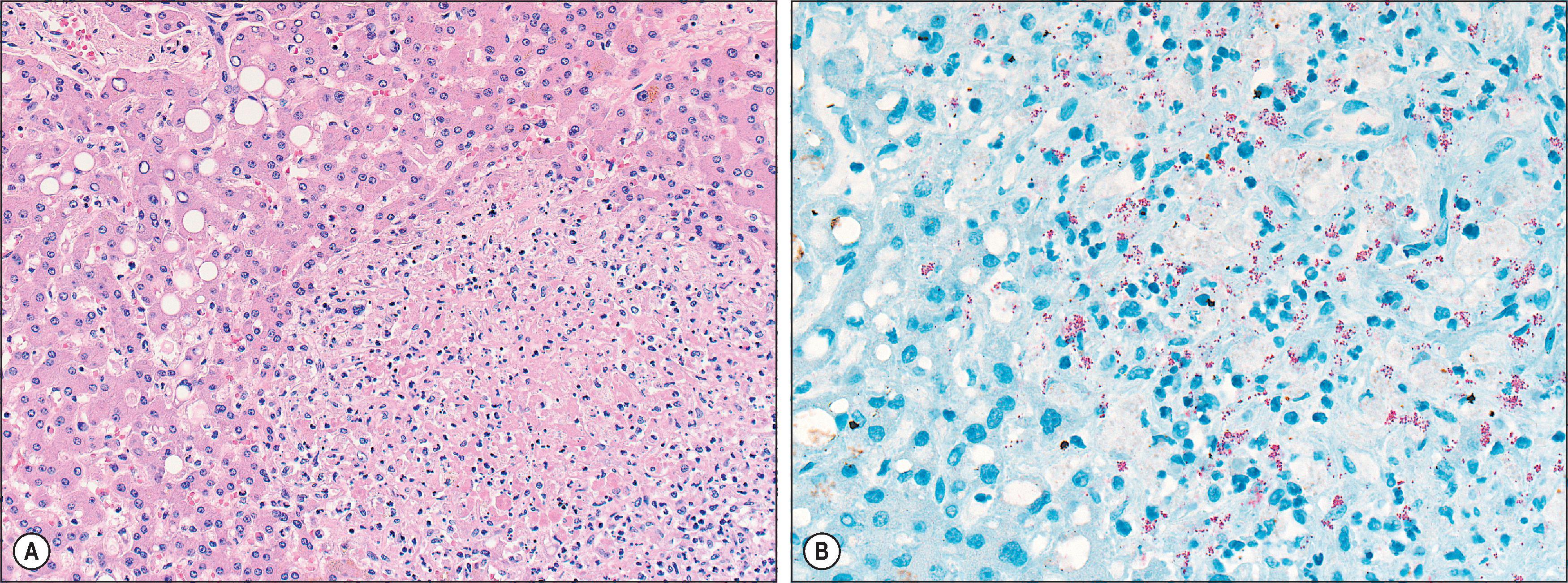
To date, there is no gold standard test to confirm Bartonella infections in clinical practice. Nonetheless, bartonelloses may be more common than previously thought, and the diagnosis should be considered in patients presenting with acute or chronic anaemia, especially those with a history of cat exposure.
Most human cases of actinomycosis are caused by Actinomyces israelii , a globally distributed soil organism. Actinomycosis of the liver is usually secondary to intra-abdominal or thoracic infection, the bacilli reaching the liver by direct extension or by the portal vein. The latter follows caecal or appendiceal infection. Occasionally, an apparently primary hepatic lesion is seen, which presents clinically as with other liver abscesses. Grossly, there is usually a honeycomb of confluent small abscesses containing greenish pus. Microscopically, amid the acute inflammation there are grains (colonies) of Actinomyces , which are basophilic in haematoxylin and eosin (H&E)-stained sections. These are composed of closely packed, radiating Gram-positive bacilli (1 µm diameter) which can be impregnated with silver by the Grocott method ( Fig. 7.35 ). There is often a fibrinoid Hoeppli–Splendore reaction at the perimeter. These abscesses may rupture, forming sinuses into the retroperitoneum.

A related infection, Nocardia brasiliensis or Nocardia asteroides , may also spread to the liver as part of haematogenous dissemination. N. asteroides is usually an opportunistic infection in immunosuppressed individuals (due to transplantation or HIV infection). The bacilli within the abscess may form grain-like colonies or may be more diffusely spread ( Fig. 7.36 ). They are also Gram positive and beaded and are silver positive on Grocott stains, but unlike Actinomyces , they are weakly acid fast, staining well with a Wade–Fite method.

Congenital syphilis often manifests early as intrauterine death or infantile disease, both with hepatosplenomegaly. In the earlier phases there may be miliary necroses, portal inflammation and hepatocyte giant cell transformation. In neonatal deaths the degree of persistent haemopoiesis is excessive for gestational age. Warthin–Starry stain demonstrates large numbers of spirochaetes, particularly in the setting of necrosis. Later the liver shows a characteristic progressive pericellular fibrosis with apparent withering of the liver cell plates ( Fig. 7.37A, B ). Immunohistochemical staining is extremely useful in confirming the diagnosis ( Fig. 7.37C ).
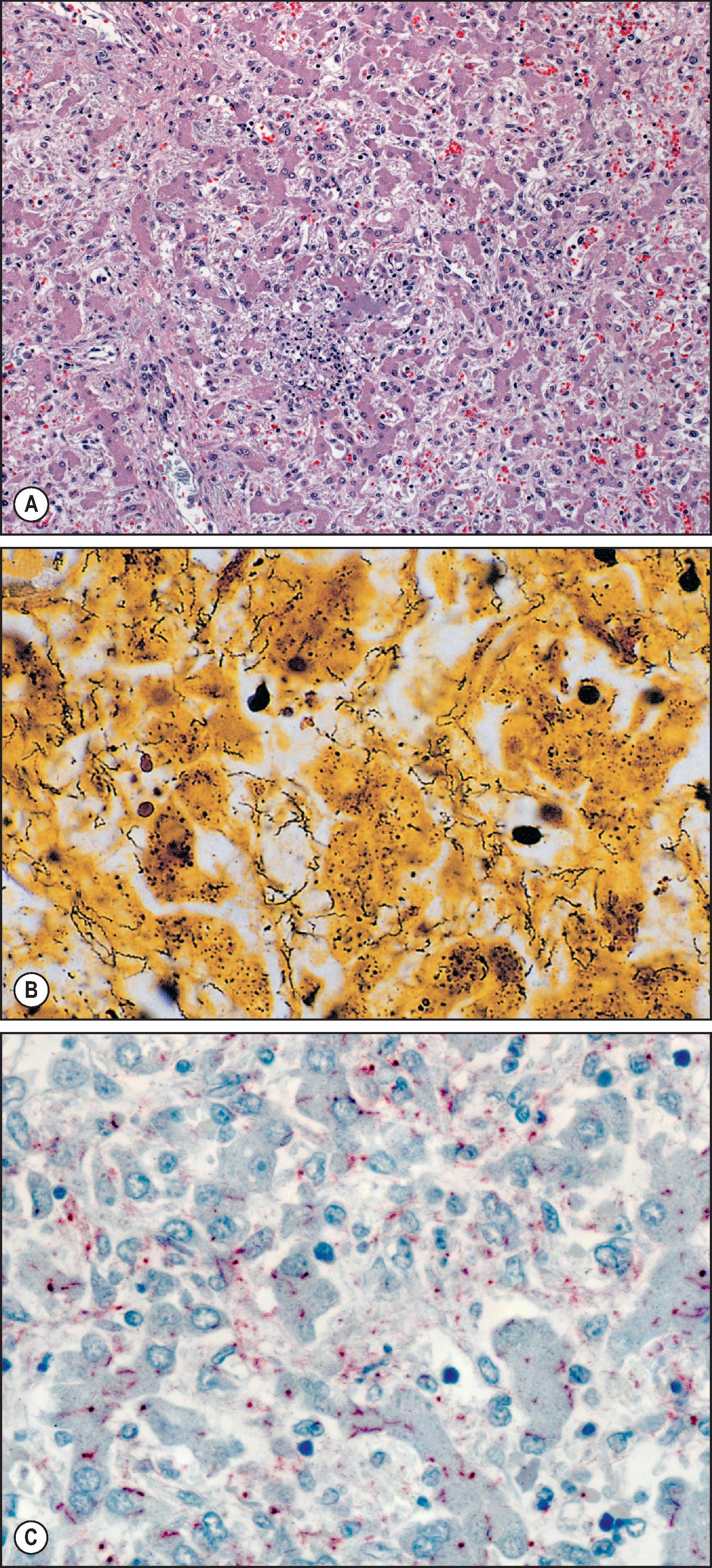
Primary syphilis has no notable liver histology, but in the secondary phase there is focal hepatocyte necrosis, portal inflammation with numerous polymorphs around bile ductules and sometimes granulomas. The portal vessels may show vasculitis. , Spirochaetes are less conspicuous than congenital lesions. The lesion of tertiary disease is the gumma ( Fig. 7.38A ). In the liver, gummas are single or multiple, ranging in size from millimetres to centimetres. Gummas are tuberculoid giant cell granulomas with amorphous, pale, necrotic centres, mimicking caseation, although the classic description emphasizes the preservation of cellular architecture within the necrotic zone. Accompanying this are plasma cells and endarteritis obliterans. Healing is by fibrosis with broad bands of scarring, which may distort the liver to produce ‘hepar lobatum’ ( Fig. 7.38B ).
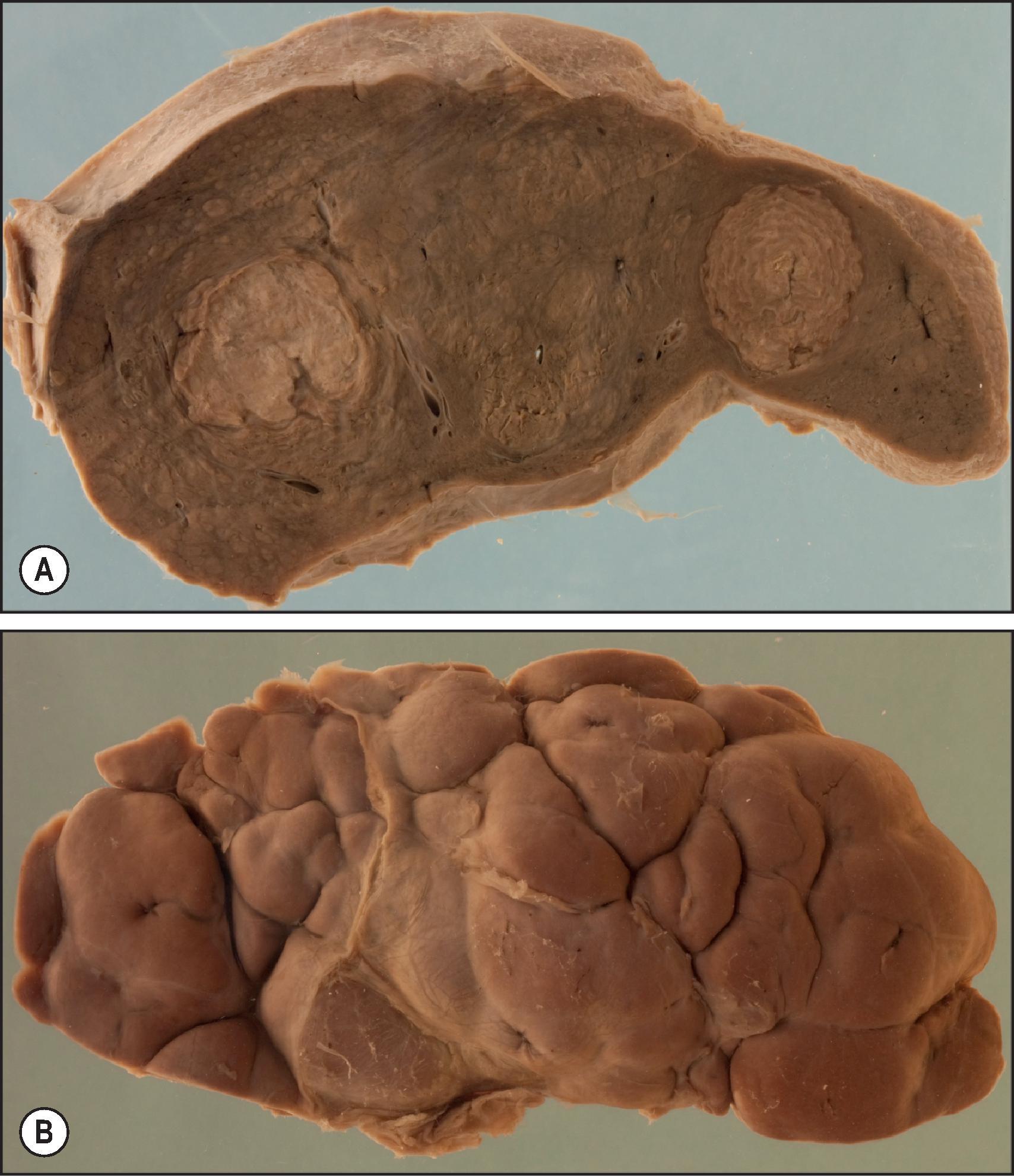
Relapsing fever may be louse- or tick-borne and is caused by many Borrelia spp. The louse-borne infection is caused by Borrelia recurrentis . Most infections occur in East Africa. As the name suggests, relapsing fever presents as periodic fever lasting 1 week and recurring another week or so later. The diagnosis is made by finding the spirochaetes in peripheral blood smears. In severe infections, jaundice and hepatosplenomegaly occur. In fatal cases an enlarged, congested liver is seen. There are foci of hepatocyte necrosis with surrounding haemorrhage in acinar zones 2 and 3. The sinusoids are infiltrated by lymphocytes and polymorphs, which are associated with Kupffer cell hypertrophy and erythrophagocytosis. Warthin–Starry or Dieterle stains may reveal the 10–20-µm-long spirochaetes lying free in the sinusoids.
Leptospirosis is a zoonosis of rats, dogs and pigs. The agent, Leptospira icterohaemorrhagica , is ubiquitous in wet environments, and humans acquire the infection by exposure to water contaminated with animal urine. The clinical features are fever with jaundice and renal failure and bleeding into conjunctiva, skin and viscera. Hepatomegaly is often present. The haemorrhagic phenomena are not caused by liver failure but by direct damage to small vessels by leptospirae. With appropriate therapy, mortality is now low.
At autopsy the liver may be normal or enlarged and icteric. The major histological features are individual hepatocyte damage, regeneration, canalicular cholestasis and only slight portal or sinusoidal lymphocytosis. Ballooning and hydropic change of hepatocytes are less marked than in viral hepatitis; apoptotic bodies are the more prominent evidence of liver damage. Many liver cells are binucleate and show mitoses; variation in size is a further indication of regenerative activity. Autopsy material shows dissociation and separation of liver cell plates ( Fig. 7.39A ), but biopsy samples usually show intact plates.
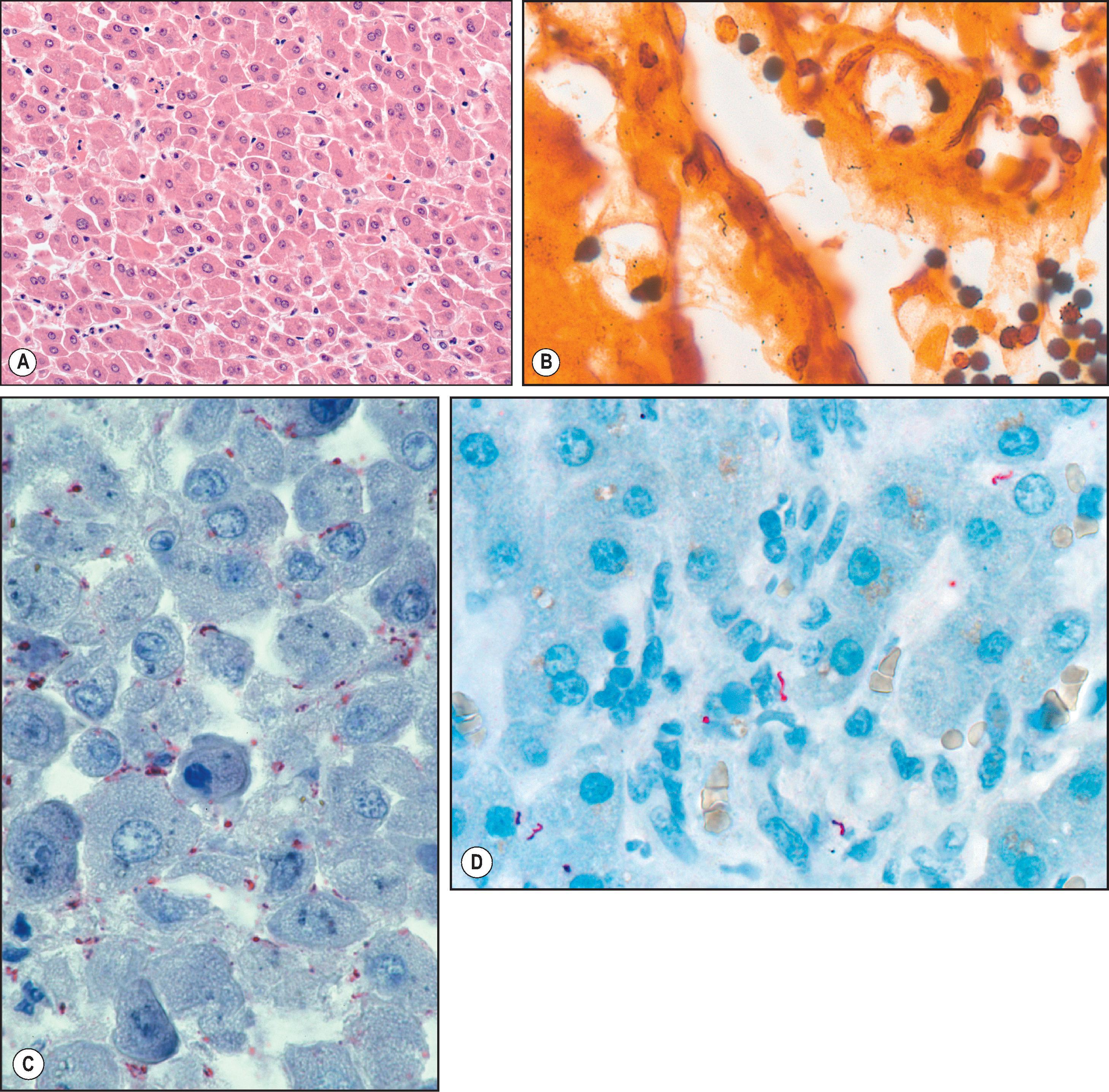
Kupffer cells are hypertrophied and contain erythrocytes. In some cases of leptospirosis, a Warthin–Starry stain shows the spirochaetes, which are 10–20 µm long ( Fig. 7.39B ). Immunohistochemical staining with specific polyclonal antibodies can demonstrate leptospiral antigens in Kupffer cells, portal tracts and endothelium ( Fig. 7.39C, D ).
Regarding disease pathogenesis, evidence from a decade of studies using human and animal samples as well as cell lines has shown that the adhesion of pathogenic Leptospira spp. to endothelial as well as epithelial cells mainly occurs through the binding of bacterial lipoproteins to host E-cadherin and VE-cadherin. , Recently, a leptospiral lipase was characterized and was detected by IHC on membranes of hepatocytes from human autopsies. This lipase, hypothetically secreted by leptospires during cell adhesion, might be relevant in cell disruption, chiefly in the liver and possibly also in other organs.
Lyme disease is a multisystem tick-borne infection caused by Borrelia burgdorferi and the closely related species Borrelia mayonii , the latter being first identified in 2013. Whereas B. burgdorferi is found throughout Europe, Asia and predominantly the northeastern and upper midwestern United States, B. mayonii has been described in the upper midwestern United States. Lyme disease has both acute and chronic clinical patterns, and the liver may be involved in both. Hepatomegaly and abnormal LFTs, associated with portal tract inflammation on biopsy, are noted in the acute disease. Recurrent Lyme disease may cause a more marked hepatitis, with ballooned hepatocytes, mitotic activity, small-droplet macrovesicular steatosis, Kupffer cell hyperplasia and sinusoidal infiltration by lymphocytes and neutrophils. On Warthin–Starry or Dieterle silver stains, spirochaetes can be seen in the sinusoids and in liver cells. ,
Among the more than 120 mycobacterial species, Mycobacterium tuberculosis and Mycobacterium leprae are the most frequent causes of human disease. The HIV/AIDS pandemic highlighted the susceptibility of immunosuppressed individuals to infection by other mycobacterioses, particularly those of the Mycobacterium avium complex. More recently, the worldwide outbreak of systemic Mycobacterium chimaera infections in immunocompetent patients exposed to contaminated heater-cooler units during cardiopulmonary bypass surgery has further increased the clinical importance of this nontuberculous mycobacteria. The pathologic features of these infections and diagnostic assays used in their identification are discussed later.
Become a Clinical Tree membership for Full access and enjoy Unlimited articles
If you are a member. Log in here